
- Catalina 12.5 Expo
- Catalina 14.2
- Catalina 14.2 Expo
- Catalina 16.5
- Catalina 22 Sport
- Catalina 22 Capri
- Catalina 275 Sport
- Catalina 315
- Catalina 355
- Catalina 385
- Catalina 425
- Catalina 445
- MAINSHEET MAGAZINE
- TRUE NORTH YACHTS

FRANK BUTLER
When Frank Butler founded Catalina Yachts in 1970, his goal was not to become the largest sailboat builder in the United States. His goal was, and still is, to build good boats that are a good value for our customers.
Accomplishing this requires planning, efficient manufacturing and well-designed boats. Catalinas do well in a very competitive market, because they are the result of listening carefully to our customers and dealers. When we design a new boat, we don´t try to reinvent the wheel each time. We incorporate proven features with new ideas and a lot of boatowners´ suggestions. This gives the line continuity, helps us avoid overly trendy styling, and insures good resale value for Catalina owners.
At Catalina we are especially proud of having the biggest percentage of repeat customers in the industry. We are all committed to maintaining the high level of customer confidence this represents. The Catalina philosophy means listening to our customers and doing our best every day.
On that promise the Catalina family will continue to grow.
CHRONOLOGICAL HISTORY
July 1969 Catalina´s first model, the Catalina 22, is built in North Hollywood, CA. Company owner Frank Butler hopes to build 100 boats if all goes well.
March 1970 Catalina´s second model, the Catalina 27, is introduced following the success of the Catalina 22.
December 1974 Catalina´s third model, the Catalina 30, is introduced; the trend-setting design is an immediate sales success and wins its class in the Newport to Ensenada Race.
February 1975 The Catalina 22 exceeds Frank Butler´s hopes to build 100 boats when hull number 5,000 is completed.
August 1979 The “International Friendship Regatta” is held in Japan; 4 U.S. and 10 Japanese crews compete in Coronado 15s.
February 1980 SAIL Magazine names the Catalina 22 “trailerable boat of the decade.”
March 1980 The Catalina 38 is selected as the match-racing boat for Congressional Cup by the Long Beach Yacht Club; Dennis Durgan wins.
September 1980 Catalina 22 hull number 10,000 is completed. C22s are being built at Catalina´s East and West Coast plants in England, Australia, and Canada.
January 1982 Patrick Childress completes a 2 1/2 year, singlehanded circumnavigation in his Catalina 27.
July 1982 The first Catalina 36 is completed at the Woodland Hills, Ca., plant.
March 1983 Mainsheet Magazine issue no. 1 is published, quickly growing to over 100 pages and 10,000 Catalina owner subscribers.
May 1984 Catalina acquires Morgan Yachts in Largo, Fl., which becomes the Morgan Division of Catalina, specializing in cruising and charter boats and building many Catalina models on the East Coast.
May 1985 Catalina 27 hull number 6,000 is built in Woodland Hills, making the C-27 the largest class of keelboats in the world.
October 1987 Catalina 30 hull number 5,000 is completed. Catalina 30s are being built at the East and West Coast plants, as well as in Canada and England.
November 1987 Singlehanded sailor Shane St. Clair sails his Capri 18 from Oxnard, Ca., to Hawaii in 28 days.
July 1988 Billy Peterson supervises the installation of the largest (70 ft.) computerized sail-plotting and cutting machine in the U.S. at the Woodland Hills, California plant.
August 1988 Coronado 15 skipper Alison Jolly becomes the first woman to skipper in the Olympics; she wins a gold medal in the women´s 470 Class.
January 1989 The first Catalina 42 is built. 100 hulls are delivered in the first year, breaking U.S. production records.
February 1990 Catalina 22 hull number 15,000 is delivered.
March 1990 The Catalina 37 is selected for the Congressional Cup, the first time a fleet of 11 has been designed and built especially for the Congressional Cup. Chris Dickson wins.
September 1990 Catalina 30 hull number 6,000 is completed, setting a new keel-boat production record.
July 1991 The first Catalina 28 is built.
August 1991 Catalina´s Morgan Division completes Procyon, a 65-foot test boat for new concepts in yacht design and construction for Olaf Harken and Procyon Inc.
November 1992 Catalina´s Morgan Division introduces the Morgan 38, the first all-new Morgan model in a decade.
December 1992 The Catalina 270 is unveiled, replacing the C-27 and wins one of Cruising World Magazine´s “Boat of the Year” awards.
February 1993 The Catalina 320 is introduced at the first “Sail Expo” and is enthusiastically received by new owners.
February 1994 The Catalina 400 is introduced at “Sail Expo,” the only twin-wheel boat built in the U.S.; it´s the hit of the show.
February 1994 The Capri 16.5 introduced at “Sail Expo,” a beach launchable performance sailing dinghy for sailors with a wide range of ages and skills
May 1994 The Catalina 250 is introduced as the first water ballast t railerable sailboat from Catalina.
January 1995 Frank Butler receives SAIL´S Industry Award for Leadership for “building boats that are “straightforward, offer price for value, are solid and honest”…”With a product analogous to the Ford in the car business, Catalina Yachts has allowed vast numbers of people to experience sailing, considering both the skill level and financial wherewithal of potential sailors, that might not have been able to otherwise, thus radically changing the sport of sailing over the past 25 years.”
January 1995 The Catalina 22 markII is introduced with re-designed and enlarged deck and new interior.
February 1995 The Catalina 22 is named as one of five charter members to Sailboat Hall of Fame.
March 1995 The Catalina 36 Mark II wins one of Cruising World Magazine´s “Boat of the Year” awards.
April 1995 Catalina 250 Hull number 100 is built in Woodland Hills.
May 1995 Catalina 42 hull number 500 is built in Woodland Hills.
February 1996 The Catalina 34 MarkII is introduced with re-designed and enlarged deck, transom and interior.
March 1996 The Catalina 28 Mark II wins one of Cruising World Magazine´s “Boat of the Year” awards.
April 1996 The Catalina 380 is introduced as reflection of the priorities expressed by experienced sailing couples and families.
November 1996 Catalina 400 Hull number 100 is built in Largo, Florida
January 1997 The Catalina 380 wins one of Cruising World Magazine´s Mid-Size Cruising “Boat of the Year” award.
January 1998 The Catalina 470 is introduced
December 1998 Frank Butler took on Sharon Day, Vice President of Sales and Gerry Douglas, V. P. of Engineering as partners in his privately held company.
January 1999 Catalina inaugurates the Catalina Cruisers Hall of Fame to honor the Catalina owners´ who have made notable voyages aboard their boats.
February 1999 The Catalina 310 is introduced and wins Cruising World Magazine´s Pocket Cruiser “Boat of the Year” award.
February 2000 The Catalina 310 is selected by Sail Magazine and it´s readers as one of the Top 10 sailboats for 2000
December 2000 Catalina 36 Hull number 2000 is built in Woodland Hills, CA
September 2001 The Catalina Capri 22 is updated and is selected by Sail Magazine and it´s readers as one of the Top 10 sailboats for 2001
May 2001 Catalina 14.2 Hull number 5000 is built in Woodland Hills, CA
January 2002 The Catalina 350 is introduced to enthusiastic reviews and results in 100 boats sold the first model year.
July 2002 The Catalina Expo 12.5 and 14.2 are introduced as particularly easy to sail for both younger and older sailors.
September 2002 Catalina Capri 22 Hull number 1000 is built in Woodland Hills, CA
January 2003 The Catalina 387 is introduced
March 2004 The Catalina 320 Hull number 1000 is built in Woodland Hills, CA
May 2004 The Catalina 18mkII is introduced with new deck, cabin house, and cockpit.
June 2004 The Catalina 22 Sport is introduced to better accomodate one-design racing.
October 2004 The Catalina Morgan 440 Deck Salon is introduced.
January 2005 The Catalina Morgan 440 wins one of Cruising World Magazine´s “Boat of the Year” awards for “Best Production Cruiser 40´ to 45´.
August 2005 The Largo, Florida, plant expands with 3 new building adding an additional 56,000 square feet of manufacturing space.
October 2005 The Catalina 309 is introduced at the St. Petersburg Boat Show
January 2006 Catalina´s technical brochure, “The Art and Science of Building America´s Favorite Sailboats” is released.
October 2006 The Catalina 320mkII is introduced.
January 2007 The Catalina 309 wins Cruising World magazine´s “Domestic Boat of the Year” award as well as “Best Small Cruiser” award.
June 2007 The Catalina 350mkII is introduced.
June 2007 The Catalina 250mkII is introduced.
November 2007 Catalina 42 hull number 1,000 is built.
January 2008 Catalina 375 is introduced.
January 2009 The Catalina 375 is awarded “Best All Purpose Cruiser 30-40 ft.”
April 2009 Catalina 445 is introduced.
July 2009 Catalina celebrates its 40th year.
December 2010 The Catalina 445 wins Cruising World Magazine´s “Boat of the Year Award”, “Best Full Size Cruiser” and SAIL Magazine´s “Best Cruising Monohull Under 50 ft.”
October 2010 Catalina 355 is introduced at the United Staes Sailboat Show in Annapolis, MD.
January 2011 Catalina 355 wins Cruising World’s “Domestic Boat of the Year” award.
October 2011 Catalina 385 is introduced at the United States Sailboat Show in Annapolis, MD.
January 2012 The Catalina 385 is named SAIL Magazine’s “Best New Boat”.
October 2012 The Catalina 315 is introduced at the United States Sailboat Show in Annapolis, MD.
January 2013 The Catalina 315 wins Cruising World’s “Boat of the Year” as Best In-Shore Cruiser and SAIL Magazine’s “Best New Boat Award”.
October 2013 The Catalina 275 Sport is introduced at the United States Sailboat Show in Annapolis, MD.
January 2014 The Catalina 275 Sport wins Cruising World’s “Best Pocket Cruiser” and Sailing Worlds “Best Recreational Racer”, the first time the same boat has won both awards in 33 years.
January 2014 Catalina 355 #100 is delivered to Sail Place, Inc. for Strictly Sail Chicago show.
May 2014 Catalina 445 #100 is delivered to Little Yacht Sales in Texas.
October 2016 The much anticipated Catalina 425 makes a world debut at the United States Sailboat Show in Annapolis, MD.
January 2017 The Catalina 425 wins Cruising World’s “Boat of the Year” and SAIL Magazine’s “Best Boat” awards.
NATIONAL SAILING HALL OF FAME
In 2013 frank butler was inducted into the national sailing hall of fame..
“I am so proud to sit with these superstar sailors,”, said Butler in reference to his fellow Inductees.
“I remember when I built my very first boat. I was about 12-13 years old. I made a boat that was about two feet long; it was a sailboat… I never thought at that time I’d be building 60,000 boats. I enjoyed it…it was not work. It was so much fun.”
PROUDLY OWNED, DESIGNED & BUILT IN AMERICA
Additional resources.
- Brochure Archives
- Associations
PARTS & TECH SUPPORT
727-544-6681
7200 Bryan Dairy Rd
Largo, FL. 33777
Great choice! Your favorites are temporarily saved for this session. Sign in to save them permanently, access them on any device, and receive relevant alerts.
- Sailboat Guide
Catalina 27
Catalina 27 is a 26 ′ 10 ″ / 8.2 m monohull sailboat designed by Robert Finch and Frank V. Butler and built by Catalina Yachts, Cooper Enterprises Inc., Eric Birch, Essex, and Russell Marine, Essex between 1971 and 1991.

- 3 / 69 Oxnard, CA, US 1973 Catalina 27 $15,900 USD View
- 4 / 69 Chicago, IL, US 1990 Catalina 27 $16,000 USD View
- 5 / 69 Northbridge, MA, US 1976 Catalina 27 $4,500 USD View
- 6 / 69 Baltimore, MD, US 1986 Catalina 27 $8,000 USD View
- 7 / 69 Somers, MT, US 1990 Catalina 27 $16,000 USD View
- 8 / 69 Oxnard, CA, US 1973 Catalina 27 $15,900 USD View
- 9 / 69 Dillon, CO, US 1984 Catalina 27 $13,000 USD View
- 10 / 69 Clear Lake Shores, TX, US 1985 Catalina 27 $7,500 USD View
- 11 / 69 Northbridge, MA, US 1976 Catalina 27 $4,500 USD View
- 12 / 69 Somers, MT, US 1990 Catalina 27 $16,000 USD View
- 13 / 69 Oxnard, CA, US 1973 Catalina 27 $15,900 USD View
- 14 / 69 Chicago, IL, US 1990 Catalina 27 $16,000 USD View
- 15 / 69 Clear Lake Shores, TX, US 1985 Catalina 27 $7,500 USD View
- 16 / 69 Northbridge, MA, US 1976 Catalina 27 $4,500 USD View
- 17 / 69 Baltimore, MD, US 1986 Catalina 27 $8,000 USD View
- 18 / 69 Oxnard, CA, US 1973 Catalina 27 $15,900 USD View
- 19 / 69 Dillon, CO, US 1984 Catalina 27 $13,000 USD View
- 20 / 69 Chicago, IL, US 1990 Catalina 27 $16,000 USD View
- 21 / 69 Northbridge, MA, US 1976 Catalina 27 $4,500 USD View
- 22 / 69 Baltimore, MD, US 1986 Catalina 27 $8,000 USD View
- 23 / 69 Somers, MT, US 1990 Catalina 27 $16,000 USD View
- 24 / 69 Oxnard, CA, US 1973 Catalina 27 $15,900 USD View
- 25 / 69 Dillon, CO, US 1984 Catalina 27 $13,000 USD View
- 26 / 69 Chicago, IL, US 1990 Catalina 27 $16,000 USD View
- 27 / 69 Clear Lake Shores, TX, US 1985 Catalina 27 $7,500 USD View
- 28 / 69 Somers, MT, US 1990 Catalina 27 $16,000 USD View
- 29 / 69 Oxnard, CA, US 1973 Catalina 27 $15,900 USD View
- 30 / 69 Dillon, CO, US 1984 Catalina 27 $13,000 USD View
- 31 / 69 Chicago, IL, US 1990 Catalina 27 $16,000 USD View
- 32 / 69 Clear Lake Shores, TX, US 1985 Catalina 27 $7,500 USD View
- 33 / 69 Northbridge, MA, US 1976 Catalina 27 $4,500 USD View
- 34 / 69 Baltimore, MD, US 1986 Catalina 27 $8,000 USD View
- 35 / 69 Somers, MT, US 1990 Catalina 27 $16,000 USD View
- 36 / 69 Oxnard, CA, US 1973 Catalina 27 $15,900 USD View
- 37 / 69 Dillon, CO, US 1984 Catalina 27 $13,000 USD View
- 38 / 69 Clear Lake Shores, TX, US 1985 Catalina 27 $7,500 USD View
- 39 / 69 Northbridge, MA, US 1976 Catalina 27 $4,500 USD View
- 40 / 69 Baltimore, MD, US 1986 Catalina 27 $8,000 USD View
- 41 / 69 Oxnard, CA, US 1973 Catalina 27 $15,900 USD View
- 42 / 69 Chicago, IL, US 1990 Catalina 27 $16,000 USD View
- 43 / 69 Clear Lake Shores, TX, US 1985 Catalina 27 $7,500 USD View
- 44 / 69 Baltimore, MD, US 1986 Catalina 27 $8,000 USD View
- 45 / 69 Oxnard, CA, US 1973 Catalina 27 $15,900 USD View
- 46 / 69 Chicago, IL, US 1990 Catalina 27 $16,000 USD View
- 47 / 69 Baltimore, MD, US 1986 Catalina 27 $8,000 USD View
- 48 / 69 Oxnard, CA, US 1973 Catalina 27 $15,900 USD View
- 49 / 69 Chicago, IL, US 1990 Catalina 27 $16,000 USD View
- 50 / 69 Clear Lake Shores, TX, US 1985 Catalina 27 $7,500 USD View
- 51 / 69 Baltimore, MD, US 1986 Catalina 27 $8,000 USD View
- 52 / 69 Oxnard, CA, US 1973 Catalina 27 $15,900 USD View
- 53 / 69 Chicago, IL, US 1990 Catalina 27 $16,000 USD View
- 54 / 69 Clear Lake Shores, TX, US 1985 Catalina 27 $7,500 USD View
- 55 / 69 Chicago, IL, US 1990 Catalina 27 $16,000 USD View
- 56 / 69 Clear Lake Shores, TX, US 1985 Catalina 27 $7,500 USD View
- 57 / 69 Baltimore, MD, US 1986 Catalina 27 $8,000 USD View
- 58 / 69 Chicago, IL, US 1990 Catalina 27 $16,000 USD View
- 59 / 69 Clear Lake Shores, TX, US 1985 Catalina 27 $7,500 USD View
- 60 / 69 Baltimore, MD, US 1986 Catalina 27 $8,000 USD View
- 61 / 69 Chicago, IL, US 1990 Catalina 27 $16,000 USD View
- 62 / 69 Clear Lake Shores, TX, US 1985 Catalina 27 $7,500 USD View
- 63 / 69 Baltimore, MD, US 1986 Catalina 27 $8,000 USD View
- 64 / 69 Chicago, IL, US 1990 Catalina 27 $16,000 USD View
- 65 / 69 Clear Lake Shores, TX, US 1985 Catalina 27 $7,500 USD View
- 66 / 69 Baltimore, MD, US 1986 Catalina 27 $8,000 USD View
- 67 / 69 Chicago, IL, US 1990 Catalina 27 $16,000 USD View
- 68 / 69 Chicago, IL, US 1990 Catalina 27 $16,000 USD View
- 69 / 69 Chicago, IL, US 1990 Catalina 27 $16,000 USD View
Rig and Sails
Auxilary power, accomodations, calculations.
The theoretical maximum speed that a displacement hull can move efficiently through the water is determined by it's waterline length and displacement. It may be unable to reach this speed if the boat is underpowered or heavily loaded, though it may exceed this speed given enough power. Read more.
Classic hull speed formula:
Hull Speed = 1.34 x √LWL
Max Speed/Length ratio = 8.26 ÷ Displacement/Length ratio .311 Hull Speed = Max Speed/Length ratio x √LWL
Sail Area / Displacement Ratio
A measure of the power of the sails relative to the weight of the boat. The higher the number, the higher the performance, but the harder the boat will be to handle. This ratio is a "non-dimensional" value that facilitates comparisons between boats of different types and sizes. Read more.
SA/D = SA ÷ (D ÷ 64) 2/3
- SA : Sail area in square feet, derived by adding the mainsail area to 100% of the foretriangle area (the lateral area above the deck between the mast and the forestay).
- D : Displacement in pounds.
Ballast / Displacement Ratio
A measure of the stability of a boat's hull that suggests how well a monohull will stand up to its sails. The ballast displacement ratio indicates how much of the weight of a boat is placed for maximum stability against capsizing and is an indicator of stiffness and resistance to capsize.
Ballast / Displacement * 100
Displacement / Length Ratio
A measure of the weight of the boat relative to it's length at the waterline. The higher a boat’s D/L ratio, the more easily it will carry a load and the more comfortable its motion will be. The lower a boat's ratio is, the less power it takes to drive the boat to its nominal hull speed or beyond. Read more.
D/L = (D ÷ 2240) ÷ (0.01 x LWL)³
- D: Displacement of the boat in pounds.
- LWL: Waterline length in feet
Comfort Ratio
This ratio assess how quickly and abruptly a boat’s hull reacts to waves in a significant seaway, these being the elements of a boat’s motion most likely to cause seasickness. Read more.
Comfort ratio = D ÷ (.65 x (.7 LWL + .3 LOA) x Beam 1.33 )
- D: Displacement of the boat in pounds
- LOA: Length overall in feet
- Beam: Width of boat at the widest point in feet
Capsize Screening Formula
This formula attempts to indicate whether a given boat might be too wide and light to readily right itself after being overturned in extreme conditions. Read more.
CSV = Beam ÷ ³√(D / 64)
From BlueWaterBoats.org :
Launched in 1971, the Catalina 27 has been a popular favourite, enjoying the kind of commercial success that’s led to one of the longest and largest production runs of its era spanning 22 years and 6,600 boats. From the outset she was designed to be affordable (some have even said cheap) for weekend excursions, club racing and coastal cruising – offshore work was always outside of the design scope. Yet despite this there has been at least one circumnavigation demonstrating that this vessel, with the right preparation and skills, can be an ocean passage maker. We’ve included this boat here more for its popularity than its inherent seaworthiness.
The Catalina 27 was conceived in a 1970 design partnership between Robert Finch, and the founder of Catalina Yachts, Frank Butler. Butler built an incredible number of 27s at his boat factory in Southern California using modern boatbuilding processes that are not too different to methods employed today. Initial production started in 1971. She had a incredibly spacious interior and she was affordably priced at a time when cruising sailboats had captured the public imagination. These factors helped the boat find immediate success, in fact in the first three years 1,500 boats popped off the production line – that’s ten per week.
Early models were only available with outboard engines, an inboard option of an Atomic 4 engine was added in 1973, which later expanded to other engine varieties in successive years. The outboard engine option was later phased out in 1989. For shallow waters, a shoal draft winged-keel version was introduced in 1979. And popular among club racers, there was a version with a taller, more efficient, high aspect ratio rig which added 24 sq.ft. of canvas.
Production spread also to Canada and the UK. Cooper Enterprises in British Columbia, at the time one of the largest Canadian boatbuilders, produced well over a thousand boats under license for the Canadian domestic market and are a common sight around BC waterways today. While across the pond in the UK, the boat was built under license from as early as 1971 under the brand name Jaguar for UK and European markets. These were produced in Essex by Eric Birch Yachts (from 1971) and Russell Marine (from 1975) with the hulls molded by Seamaster Boats.
In 1979 a young 28 year old Patrick Childress set off in his shoal draft Catalina 27, Juggernaut , on a successful 3 year single-handed circumnavigation which included a 6400-mile, 53-day passage of the Indian Ocean.
After an unprecedented 22 years of production resulting in 6,600 boats, production finally ceased in 1991. Catalina succeeded the long lasting design with an all-new water-ballasted and trailerable weekender, the Catalina 270.
Configuration
The Catalina 27 is a fin-keeler with a raked spade rudder hanging about as far aft as possible, pushed along by a masthead sloop rig that’s tall and efficient. The hull shape is shallow and beamy which is great for initial stiffness to the wind but reduces liveable volume below the waterline. Butler made up for this by drawing deep topsides and a high cabin top all while keeping the design sleek to the eye. The result gives this 27-footer class leading interior headroom and space.
Below deck can best be described as light and spacious, this boat offers so much accommodation that many are willing to forgo her flaws. The companionway and hatch is wide which poses a water ingress hazard at sea but is responsible for her spacious feel in the cabin while at anchor. There’s technically berths for six in the standard aft-galley layout – two in the forepeak and the port side settee will really only fit kids or very short adults, while the starboard settee converts to a cozy double berth, and finally there’s a starboard seagoing quarterberth. The galley with its two burner stove is located on port below the companionway while the head is located just aft of the forepeak on starboard and is comfortably sized. Opposite the head is a locker, but note, as is typical of boats this size, locker and stowage space is in short supply.
Construction
Construction was pretty light. The hull is of solid fiberglass and much thinner than typical offshore counterparts, particularly above the waterline where small impacts that would normally lead to just a scratch may result in fractures for the Catalina 27. Early boats, as a cost cutting measure, lacked proper backing plates on deck hardware, stanchions, and rails, which lead to cracked gelcoat and in some cases fiberglass delamination. This was remedied in later boats.
The feel of the helm is very light and she sails responsively, or to quote the ever humorous John Vigor in 20 Small Sailboats to Take you Anywhere, “She handles like a dinghy, which is hardy surprising since that’s what she basically is – a dinghy with grandeur”. She is relatively stiff and holds her canvas well in a breeze. All this makes for a fast boat that’s easily controlled. The downside is seaworthiness. For best results Vigor recommends keeping her cruising weight down, as reduced weight will reduce stresses on the rig and hull at sea.
Note that the Catalina 27 is a beamy boat, and like others, there is a tendency for weather helm on greater angles of heel that will require either reefing the mainsail to maintain balance.
Buyers Notes
More than 6,600 Catalina 27s were made, so there’s plenty to choose from. If you’re on the hunt for a boat to sail protected coastal waters at a good price then she’s a good choice. For offshore work do your research and make sure you’ve modified your boat according to recommendations – probably the most important are enlarging the cockpit drains, reworking the companionway hatch area to help direct water into the cockpit, and uprated rigging including chainplates for the aft lower shrouds.
Some known weaknesses with this boat are listed below:
- As mentioned, early boats lacked backing plates on hardware, leading to cracks in the gelcoat and in some cases delamination of the GRP.
- Through-hull fittings were poorly installed and secondary bondings of attachments in some cases were poor.
- Leaky chain plates have caused bulkheads to deteriorate which in turn has increased the risk of rig failures.
- Fuel tank installations were poor on early inboard models.
- The original spreader sockets were made of cast aluminium which tended to crack when overstressed.
- Through-hull fittings in early boats were simply pipe nipples glassed into the hull and will need swapping out for proper flanged, bolt-through bronze fittings.
- While heeled, some have reported seawater back flowing into the icebox via the drain. Fit a proper seacock to the through-hull.
Links, References and Further Reading
» The Catalina 27/270 Owners Association » Twenty Small Sailboats to Take You Anywhere by John Vigor, (Ch8, p45-52) an in depth look at the Catalina 27. ISBN:978-0939837328 » Used Boat Notebook, Catalina 27, review by John Kretschmer, SAILING Magazine, Nov 2002, volume 37, no. 3 » Jaguar Owners Association for European Catalinas under the brand name Jaguar » A biography of Forbes Cooper of Cooper Yachts who built the Canadian Catalina 27s » Cruising World Magazine’s article on Patrick Childress’ two circumnavigations , first in his Catalina 27 and then in his Valiant 40 two decades later.
Embed this page on your own website by copying and pasting this code.

Discover Related Sailboats

Twenty Small Sailboats to Take You Anywhere
John Vigor turns the spotlight on twenty seaworthy sailboats that are at home on the ocean in all weather. These are old fiberglass boats...

Blue Water Boats
This collection of capable blue water boats features time-tested sailboats with rich histories.

Catalina 30

Albin Vega 27

Catalina 270

Pearson Triton
- About Sailboat Guide
©2024 Sea Time Tech, LLC
This site is protected by reCAPTCHA and the Google Privacy Policy and Terms of Service apply.
- New Sailboats
- Sailboats 21-30ft
- Sailboats 31-35ft
- Sailboats 36-40ft
- Sailboats Over 40ft
- Sailboats Under 21feet
- used_sailboats
- Apps and Computer Programs
- Communications
- Fishfinders
- Handheld Electronics
- Plotters MFDS Rradar
- Wind, Speed & Depth Instruments
- Anchoring Mooring
- Running Rigging
- Sails Canvas
- Standing Rigging
- Diesel Engines
- Off Grid Energy
- Cleaning Waxing
- DIY Projects
- Repair, Tools & Materials
- Spare Parts
- Tools & Gadgets
- Cabin Comfort
- Ventilation
- Footwear Apparel
- Foul Weather Gear
- Mailport & PS Advisor
- Inside Practical Sailor Blog
- Activate My Web Access
- Reset Password
- Pay My Bill
- Customer Service

- Free Newsletter
- Give a Gift

How to Sell Your Boat

Cal 2-46: A Venerable Lapworth Design Brought Up to Date

Rhumb Lines: Show Highlights from Annapolis

Open Transom Pros and Cons

Leaping Into Lithium

The Importance of Sea State in Weather Planning

Do-it-yourself Electrical System Survey and Inspection

Install a Standalone Sounder Without Drilling

When Should We Retire Dyneema Stays and Running Rigging?

Rethinking MOB Prevention

Top-notch Wind Indicators

The Everlasting Multihull Trampoline

Check Your Shorepower System for Hidden Dangers

How Dangerous is Your Shore Power?

DIY survey of boat solar and wind turbine systems

What’s Involved in Setting Up a Lithium Battery System?

The Scraper-only Approach to Bottom Paint Removal

Can You Recoat Dyneema?

Gonytia Hot Knife Proves its Mettle

How to Handle the Head

The Day Sailor’s First-Aid Kit

Choosing and Securing Seat Cushions

Cockpit Drains on Race Boats

Re-sealing the Seams on Waterproof Fabrics


Safer Sailing: Add Leg Loops to Your Harness

Waxing and Polishing Your Boat

Reducing Engine Room Noise

Tricks and Tips to Forming Do-it-yourself Rigging Terminals

Marine Toilet Maintenance Tips

Learning to Live with Plastic Boat Bits
- Sailboat Reviews
The Catalina 34, 30 Years Later
Attractive prices draw sailors from all coasts to this mid-size cruiser.
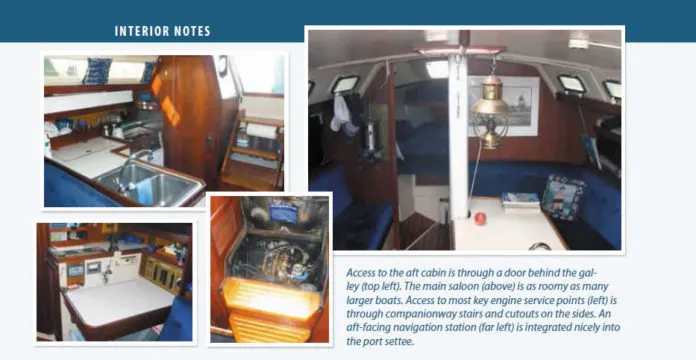
American sailboat manufacturers have had their highs and lows, and many have dropped right off the map, but Catalina has been going strong for more than four decades, and looks to be gearing up for at least 40 more. If you want a history lesson in how owner Frank Butler navigated this company through a fickle, cyclical industry, you can check out one of our many reviews of Catalina boats online at Practical Sailor . The more recent trends are the most relevant to this boat review, an update to one originally published in 1991.
Since 2010, Catalina has been redesigning its big-boat fleet (27-feet and longer). These are Series 5 boats denoted by the 5 at the end of their name. These include the 44-foot 445, the 37-foot 375 (see PS October 2010 ), the 35-foot 355, the 31-foot 315, and the 27-foot 275. Aside from beamier hull shapes, easier maintenance, and roomier interiors, these newer designs raise the bar on production quality. The approach makes marketing sense. If price alone is what a sailor cares about, Catalina can’t compete with itself-too many of its older boats are still on the market. Which brings us to the Catalina 34.
Exactly 1,800 Catalina 34s were built between the years 1991-1999, and the boat has gone through several iterations. The hull we focus on here is the relatively narrower one built between 1986 and 1995, generally referred to as the Mark 1, or Mark 1.5. The Catalina 34 sold between 1994 and 2001 (production run officially ended in 1999) is known as the Mark II has a larger cockpit. The boats are easiest to recognize from the stern-the Mark I has a traditional closed transom, the Mark 1.5 has a cutout for accessing a swim ladder, and the Mark II has an open transom.
There is nothing fancy about the design. Except for the old Catalina 38 (which was not a Frank Butler design), all Catalinas of this era have a similar conservatively modern look-fin keel and spade rudder, short overhangs, and a flattish sheerline. The distinctive cabin house and diamond-shaped sail emblem help identify a Catalina. The hull of the 34 is modern, with full sections to provide lots of room below. It seems more refined than the original (Mark I) Catalina 27, 30, and 36, which is probably why we prefer the 34. Like Catalinas of this era, the 34 combines a long waterline, a moderate to light displacement, and a large sail area to ensure good sailing performance. Some recent improvements such as a new elliptical rudder ($1,200 plus shipping) have raised performance a notch.
There are some design details we don’t like, such as the huge companionway hatches and molded furniture pans that limit access to the hull. The more serious complaints-slop in the rudder bearing, messy wiring-seem reserved to older boats.
Overall, we cannot take serious objection to any important aspect of the design. The 34s are wholesome coastal cruising boats, also suitable for island-hopping expeditions. Although some European boats have notched adventures in the North Atlantic, wed look at beefier designs for long offshore work. With any 20-plus year old hull, wed consider dropping the rudder and keel for inspection before heading too far offshore. The post 1988 era also brought in a five-year warranty against blisters, a problem reported on earlier hulls.
When Practical Sailor first took a close look at the Catalina 34 back in 1990, we were impressed by the equipment. Self-tailing primary winches are standard and adequately sized; sail-handling hardware is all good; brand-names abound everywhere-stove, pressure-water pump, and head. With rare exception (the traveller system and leaky ports in pre-1988 hulls), the deck hardware has held up well on this boat.
The list of standard equipment was complete enough that you could conceivably sail the boat away with no options, a far cry from the old-fashioned method of selling a base boat with no lifelines, bilge pumps, or cushions aboard. The 1990 boat we looked at carried a base price of $60,100 (approximately $110,000 in 2015 dollars), which included a mainsail and 110-percent jib, mainsail cover, two-burner stove with oven, hot and cold pressure-water system, two batteries, 110-volt shore power system, boarding ladder, and lots of other equipment.
Although prized in areas where local fleets are active, the Catalina 34 Mark I cannot be expected to hold its value as time passes. At last check, there were about three-dozen boats for sale in the U.S. Prices have continued to fall. The rate of depreciation can vary by region. Asking prices for a fully equipped 1990 Catalina 34 today is between $40,000 and $50,000.
The interior design is in the European mode, the first of the Catalinas to have the head aft by the companionway. Unlike European boats of this era, such as the Beneteau or Jeanneau of the same size, however, the Catalina is very full forward, with a big V-berth cabin and a big dinette and settee ahead of the L-shaped galley and nav station. (Some early models had the water tank forward, which is less desirable.)
The starboard-side aft cabin-entered through the galley-will likely be used as a guest cabin or storage space, especially in warmer climates where limited ventilation makes it less desirable than the V-berth for sleeping. It has a sizable athwartship berth, and theres a seating area between the berth and the galley. Cooks are never happy with a door that opens into their galley, but this is a necessary compromise for having an aft head, a valuable asset on a sea boat, where it can double as a wet locker for foul weather gear. The other galley complaint was the limited storage for LPG gas in earlier models, although members of the very active owners association offer various ways to solve this.
According to our owner survey, the interior is the most praised aspect of the 34, with comments like most room for the money appearing in a majority of reports.
Performance
The second most highly praised feature is performance, with several owners commenting on the boats favorable PHRF rating in their local fleets. We sailed the 34 on Lake Michigan, and found the boat to be a delight to sail.
It was a puffy day, so the boat was occasionally over-canvased and developed a strong weather helm-something that the newer, longer elliptical rudder solves. A flatter mainsail helps as well (the original Catalina sails on older boats have a fuller cut). Even with a well-cut mainsail, we suspect that cruisers will want to take an early reef as the wind builds. The standard furling jib in Southern California and the Chesapeake is a 155-percent genoa. Sailors in windier areas may want to invest in 110-percent working jib, which will perform better than the furled headsail.
The 34 sailed well on all points of sail, but it could have used an asymmetrical downwind. With a PHRF rating around 144, she is about in the middle of the speed range for contemporary boats her size, considerably slower than the J/35 but significantly faster than the Crealock 34.
Wed call her sailing ability respectable, good enough to make smart cruising passages and quick enough to sail to her handicap rating on the race course.
The Catalina 34 we sailed had the standard 5-foot, 7-inch draft fin keel, but the boat also is available with a wing keel option, drawing 3 feet, 10 inches. A tall rig, which adds 26 square feet of mainsail (a 5 percent increase), is also an option. Several respondents to our owner survey gave decidedly mixed reviews to the wing; others praising its seaworthiness and the good ride. Unless we were desperate for the shallow draft, wed be inclined to go with the standard fin rather than the wing. The nice thing about the fin keel is that you can upgrade to the longer elliptical rudder, a widely praised upgrade that greatly reduced the boats tendency to round up in puffs and adds lift. The new elliptical rudder for the wing keel version is not as deep, so the performance gains are not as noticeable.
Standard power is a three-cylinder Universal 25 diesel, which we found adequate. However, owners again report mixed feelings about the engine. Vibration with the two-bladed prop is a common complaint; a few thought the boat was underpowered. A three-bladed 15 x 10-inch prop (or the Catalina-specified 15 x 9 inch prop) solves both these problems. If you are looking at a pre-1988 boat, you’ll want to make sure it has the new alternator mount, which came with the upgraded Universal 25XP. Without this upgrade, you run a risk of the cylinder head cracking because of vibration.
Racers or performance cruisers who don’t want the drag of a three-bladed prop can opt for a feathering prop like the Autoprop, a folding Maxprop, or-the cheapest option-a well-balanced Martec two-blade.
Construction
Layup, laminates, plywood deck core (not balsa), and other construction details are conventional. The boat is generally well engineered and well-executed. It is certainly adequate for typical coastal cruising, weekending, and daysailing.
If good engineering is defined as doing a good job of adapting means to ends, or materials to functions, then the Catalina 34 is well-engineered.
The foredeck seemed to have a little more flex compared to balsa- or foam-cored boats in this class. But we know a 1972 Catalina 27 well, and its foredeck has the same feel now that it had when new. It has served well and, we must conclude, it was engineered and built as planned. We don’t like the way the pan liner flexes either, or the way it hides most of the inside of the hull, but it holds up and it performs the cosmetic function for which it was intended.
The chainplates seem small when we compare them to the half-inch stainless plates on a boat like the Carter 36. But we’ve never heard of a Catalinas chainplates failing, and they’re undoubtedly up to the job.
Some boats are overbuilt, which can be expensive-a waste of money for an American coastal sailor who has no plans to sail in the Southern Ocean. Worse is to build a boat no better than the Catalina 34 and charge $30,000 more.
The Catalina 34 is a successful, all-around design from a hugely successful company. Because Catalina sells so many boats and runs an efficient manufacturing facility, its boats typically sell for less than other brands of comparable size. The relatively large number of used Catalinas on the market mean that a buyer can be quite selective.
In general, satisfaction with the Catalina 34 rates very high. We suspect this is due in large part to the great support that owners get through the Catalina 34 International Association, Catalina, and Catalina Direct, an independent provider of upgrades and parts for older boats. This wide forum means that prospective Catalina owners buy with their eyes wide open-there are very few surprises that a previous owner has yet encountered-so long as they do their research.
We do not recommend the Catalina 34 for extended offshore cruising, at least not without making some modifications to the companionway, upgrading the rigging, and possibly stiffening areas of the hull.
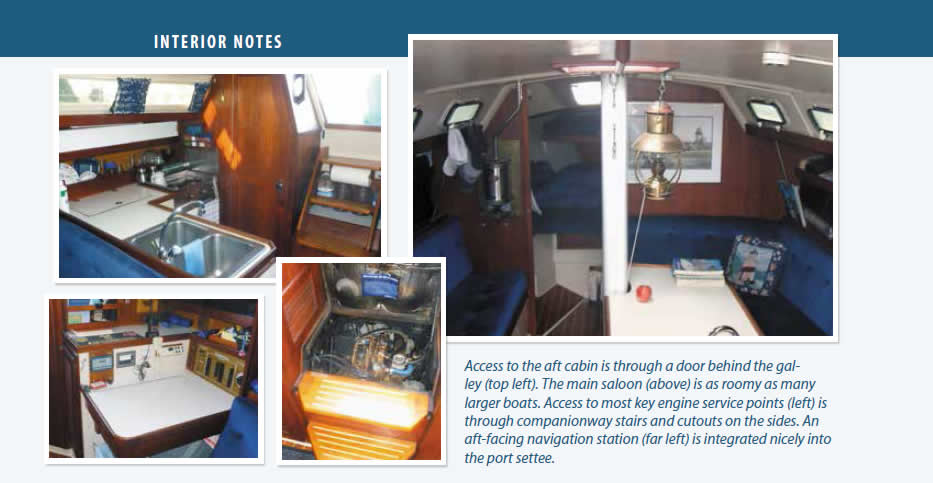
- Catalina 34 International Association
- Catalina Direct
- Catalina Yachts
RELATED ARTICLES MORE FROM AUTHOR
Your Catalina 34 review was right on the money. I had many boats, and the ’86 Catalina 34 was so good that I kept her for 21 years. It had all of the problems that you mentioned including blisters, rounding, traveler, wiring, and loose steering post, but to me it was all a challenge that I enjoyed taking care of. After all, isn’t that part of the fun of owning a boat? The pros greatly outweighed the cons. I am a cruiser, and enjoyed countless voyages to new and old ports. She was a pleasure to own and sail. The association with its many members offered lots of ideas, and I used many of them. I love recounting them with sailing friends. I met Frank Butler at several gatherings, and he was always most helpful.
I’m looking at a ’87 and would appreciate some insight. email me at [email protected] if you can share some feedback, etc.
My Catalina 34 1987 is on the market at RacineRiverside.com. She’s been a wonderful companion for 17 years. Sadly, I need to make a change.
LEAVE A REPLY Cancel reply
Log in to leave a comment
Latest Videos

40-Footer Boat Tours – With Some Big Surprises! | Boat Tour

Electrical Do’s and Don’ts

Bahamas Travel Advisory: Cause for Concern?

Island Packet 370: What You Should Know | Boat Review
- Privacy Policy
- Do Not Sell My Personal Information
- Online Account Activation
- Privacy Manager
The Catalina Preservation Society
Pby catalina history, consolidated pby / catalina / canso history.
A brief PBY History by: John Clement
Development
The plane that would become the PBY Catalina was designed by Consolidated Aircraft Corporation’s lead designer, Isaac Machlin (“Mac”) Laddon when, in 1933, the United States Navy, wary of Japan’s growing influence in the Pacific Ocean, requested competing prototype designs for a flying boat with a range of 3,000 miles and a cruising speed of 100 mph to patrol Pacific seas in search of hostile navy forces.
Flying boats were the dominant long-range aircraft of the day in that they did not require runway construction. Laddon was able to draw on Consolidated experience building two previous flying boats for the Navy.
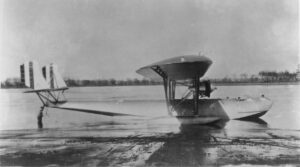
Further testing resulted in design adjustments to modify the vertical tail structure and dorsal fin (See image below) to prevent the tail from becoming submerged on takeoff and to upgrade the aircraft from “Patrol” to “Patrol Bomber” status.
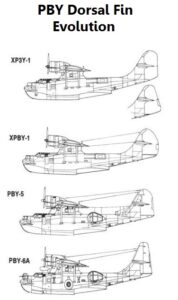
The first flight of the modified XP3Y-1 in October, 1935, set a record for non-stop distance flight of 3,443 miles for a Class “C” seaplane from Cristobal Harbor, Panama Canal Zone, to Alameda, California in 34 hours 45 minutes. A flight which did reveal the need for more powerful engines. After the power-plant update, the plane was re-delivered to the Navy as XPBY-1 (PB for Patrol Bomber; Y for Consolidated in accordance with the US Navy aircraft manufacturer’s designation system). [1]
Classified by Consolidated as Model 28, production models from PBY-1 to PBY-3 were incrementally upgraded to enhance performance. PBY-4, designed to continue the pattern of gradual improvement with Pratt and Whitney 1,050hp radial engines, would, over its production run from May, 1938 to June, 1939, mark a great leap forward.
In a few later production models of the PBY-4 , Plexiglass blisters which replaced the sliding hatches over the waist guns would become standard on subsequent models. They enhanced the gunners’ view of the enemy but also served as perfect observation posts for spotting enemy surface vessels.
The PBY-5 flying boat did not have wheels but they could be rolled onto land for maintenance using beaching gear, light duty wheels and struts that had to be installed by crew members in swim suits and removed once they had been rolled into the water once again.
But, a proper landing gear was required to transform the PBY Catalina to a truly amphibious aircraft. The prototype, XPBY-5A BuNo 1245, made its debut in late 1939. [2]
A limited number of PBY-1 to PBY-4 models had been manufactured but by 1943 production of the PBY-5 for the US Navy alone exploded (flying boat, 684 built from September 1940 to July, 1943) and PBY-5A (amphibian, 802 built between October, 1941 and January, 1945). In addition, production included aircraft for the RCAF, RAF, RAAF, and Dutch MLD.
The PBY had been manufactured by Consolidated plants in the United States at Buffalo New York, San Diego California and New Orleans . To meet the demand for the pby-5 and pby-5A, Boeing Aircraft of Canada , with a plant near Vancouver, and Canadian Vickers at St. Hubert, later Cartierville Airport near Montreal, were licensed to produce PBY’s. Boeing’s were coded PB2B; the Vickers planes were PBV.
The Soviet Union began receiving Catalina’s under Lend-Lease and producing their own under licence before World War II. The Soviet Aircraft were designated GST (Gidrosamolet transportnii/seaplane transport).
The final Consolidated PBY model, PBY-6A , appeared at the end of the war, manufactured from January 10 to May, 1945. [3]
One final wrinkle in the development of the aircraft. At about the same time that the PBY-5 and PBY-5A went into production, the US Naval Aircraft Factory designed a variant known as the PBN-1 Nomad , a larger and more rugged plane with greater range and stronger wings permitting a 2,000 pound (908 kg) increase in gross takeoff weight.
138 of the 156 Nomads produced at the Naval Aircraft Factory were delivered by air to the Soviet Union. The remaining 18 were assigned to training units at NAS Whidbey Island and the Naval Air Facility in Newport, Rhode Island. Elements of the Nomad design were incorporated in the PB2B-2 and PBY-6A.
Design Features
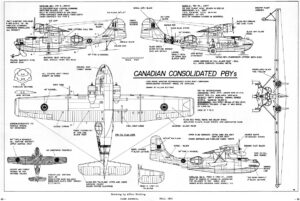
A two-step hull with a streamlined upper fuselage was attached to a parasol wing on a pylon braced by one pair of struts on each side running from the side of the hull to a position just outside the engines. This design permitted views of the ocean below unobstructed by the wing.
PBY Drawing courtesy of Al Botting
The pylon served as the flight engineer’s post with just enough room for the engine control panel, two windows through which each engine could be checked for oil leaks, and a seat raised to leave room below for other crew members.
Aft of the wing was a cabin with two bunks and a small galley.
The huge wing, 104 feet in length, was both the fuel tank that gave the PBY superior range and endurance and a strong lifting surface that gave the plane a 15,000 lb./6,600 kg payload. [4]
A no nonsense continuous I-beam spar and internal bracing contributed to wing strength. The pylon put the wing-mounted engines well above spray height since water can damage propeller tips moving just below the speed of sound.
The engines were mounted close to the fuselage to facilitate operation with one engine which increased range on long patrols but reduced the plane’s manoeuvrability on water and made it a very noisy machine to fly. [5]
A towering vertical stabilizer surface aided maneuvering on water as well as in the air.
Floats to keep the wingtips out of the water on takeoff and landing were retractable, swinging out and upward to morph into the wingtips when the craft was airborne.
Four bomb racks, two on the underside of each wing, could carry a total of four thousand pounds of bombs, depth charges or torpedoes.
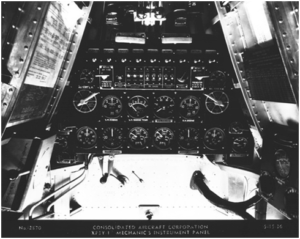
Photo taken in the flight engineer’s station within the pylon shows the instrument panel and small windows, left and right, through which the engines could be checked for oil leaks.
The result was the most aerodynamic flying boat ever designed and the most-built flying boat of World War II with a production run of about 3,305. [6]
Construction was all-metal, stressed skin aluminum sheets riveted to an aluminum frame, except the ailerons and wing trailing edge which were fabric-covered to reduce the weight of the aircraft. The fabric, unbleached cotton, was hand sewn and the seams sealed with varnish to make them water tight and add rigidity. Rivets were kept in a freezer before being driven into place to make all joins especially tight when the rivets expanded in warming to room temperature.
Many aviation experts considered the PBY obsolete when the war started.
Unobstructed view of ocean and land targets, rugged construction, long range, high payload, the PBY provided a strong military performance platform. High speed? No, but its speed was more than adequate for maritime patrol and anti-submarine warfare. “Without her crew the plane is but an inanimate object, unable to move, express itself or show off her incredible characteristics. But…together with her crew they showed the world through their collective efforts the PBY’s contribution to aviation.” [7]
It’s time now to look at what the PBY and her crews were able to do. Catalina’s served in the wartime armed forces of the U.S.A., Canada, Great Britain, Australia, New Zealand, the Soviet Union, the Netherlands, Free France and Brazil. With the United States being neutral until the Japanese attack on Pearl Harbour on December 7, 1941. The first PBY’s to enter combat in World War II were flown by Britain and her allies.
PBY Catalina’s in the Royal Air Force
In 1939, the Royal Air Force (RAF), ordered a single example of a commercial model of the PBY-4 flying boat for an evaluation which was still in progress when war was declared and a decision was made to order the aircraft in large numbers for military service. The first of about 700 Consolidated flying boats entered service in early 1941 with 209 and 240 Squadrons of Coastal Command. Many of the later aircraft were diverted to the Royal Australian Air Force (RAAF), and Royal New Zealand Air Force (RNZAF).
The RAF favoured flying boats for their longer range but did have to accept twelve PBY-5A aircraft (designated Catalina IIIA) under Lend-Lease. True to its tradition of shunning alphanumeric designations, the RAF named their PBY’s Catalina’s, a name adopted by the US Navy in October, 1941. Consolidated president Reuben Fleet may have suggested the name “Catalina”, to the RAF as this was the name of an island off the coast of California not too far from the Consolidated plant.
The Catalina’s Hollywood moment occurred on 26 May 1941 when an RAF flying boat based in Northern Ireland and co-piloted by Ensign Leonard B. Smith of the US Navy, spotted the German battleship Bismarck as it attempted to reach occupied France for repair, thus initiating the process that would see the destruction of Germany’s largest battleship. [8] Ensign Smith’s involvement was kept secret because of the official neutrality of the United States. [9]
On 17 July 1944 RAF officer John Cruickshank, piloting a Mk IV PBY Catalina JV928 from the Shetland islands, came under heavy anti-aircraft fire from German Submarine U-361. Seriously wounded, Cruickshank pressed home the attack and sank U-361 on his second pass. He was awarded the Victoria Cross and is the last living recipient to have been awarded the VC during the Second World War.
PBY Catalina’s and Canso’s in the Royal Canadian Air Force
The first PBY aircraft taken on strength by the Royal Canadian Air Force (RCAF) by No. 116 Squadron at Dartmouth, Nova Scotia on 28 June 1941,were nine Catalina Mark I flying boats diverted from an RAF contract to fulfill a request from the AOC (Air Officer Commanding) A/C (Air Commodore) A.E. Godfrey. [10]
Some flying boats were stationed on Canada’s east and west coasts for maritime patrol and convoy escort but, unlike the RAF, the RCAF favoured the amphibian PBY-5A for their Canadian squadrons since using straight flying boats was impractical during Canadian winters.
In December, 1941, the decision was made to rename PBY-5A aircraft built in Canada for the RCAF because specifications for their Canadian built models were different from British and American versions.
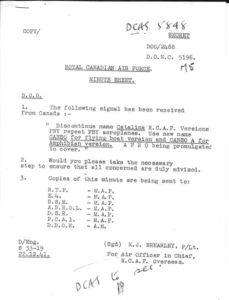
Canadian Government PBY-5 and PBY-5A naming edict
The name, “CANSO,” was chosen for the Strait of Canso located in the province of Nova Scotia, Canada dividing the Nova Scotia peninsula from Cape Breton Island. The RCAF’s non-amphibious aircraft were to be named “Canso” while the amphibians were known as “Canso As”. The Catalina’s loaned from the RAF retained their original British name. [11]
The figures reported in the next paragraph indicate that no “CANSO” flying boats meeting RCAF specifications, were built. The number of Catalina’s and Canso’s taken on strength by the RCAF in WW II were 30 ex RAF Catalina flying boats and 208 Canso A amphibians. [12]
The two RCAF overseas squadrons, 422 and 413, flew Catalina’s supplied by the RAF. No. 422 (GR/General Reconnaissance) Squadron , based at Lough Erne , Northern Ireland on 2 April 1942, ferried key personnel and equipment to northern Russia. In transit they patrolled the route of Russian convoys watching for submarines and surface raiders operating off the coast of Norway.
By March, 1942, Japan seemed to be on an inexorable march to supremacy in the Western Pacific and the South China Sea. Since the destruction of Pearl Harbour by a Japanese aircraft carrier fleet on December 7, 1941, Japan had overrun Hong Kong, Malaya, Singapore, the Dutch East Indies, and Burma. A carrier-launched air raid destroyed the northern Australian port city of Darwin. Next up, the Indian Ocean where defeat of the British Eastern Fleet would have had disastrous consequences for the allied forces confronting the Axis powers.
“The most dangerous moment of the war, and the one which caused me the greatest alarm, was when the Japanese fleet was heading for Ceylon and the naval base there. The capture of Ceylon, the consequent control of the Indian Ocean, and the possibility at the same time of a German conquest of Egypt would have closed the ring and the future would have been black”
Prime Minister Winston Churchill
The British fleet based in Ceylon (now Sri Lanka) was a mix of modern and older vessels cobbled together in haste and put under the command of Admiral Sir James Somerville who realized his only option against a superior force was to adopt a defensive stance which involved keeping his ships out of port except for refueling and taking on food and water.
His plan was to concentrate his fleet outside the range of Japanese reconnaissance aircraft during daylight and close in at night. The British could use their radar-equipped Albacores to slow the Japanese fleet enough for their battleships to engage in the dark. Stay out of range they did but the British fleet never launched an offensive against the Japanese fleet. The fleets never met.
The Japanese expectation was for complete surprise which would find Royal Navy ships confined to harbour as had happened at Pearl Harbour and Darwin. Somerville’s overarching challenge was to locate his adversaries to eliminate the element of surprise.
Cue the Catalina’s.
The RCAF’s second overseas squadron equipped with Catalina flying boats, No. 413 (GR) Squadron , was formed and stationed in Scotland before being sent to Ceylon in late March, 1942, to supplement RAF Catalina’s on the island.
Voices from the Past
On 4 April, 413 Squadron leader Leonard Birchall took off in Catalina QL-A on a reconnaissance patrol of the sea south of Ceylon. At about 4pm, after 10 hours in the air, Birchall sighted a smudge on the southern horizon. Investigating from a height of 2000 feet, he saw the Japanese fleet formation including carriers, battleships, escorts and supply ships.
Turning north under full power, it was already too late for the Catalina and its crew. The Catalina’s radio operator managed to get off a sighting report. But before he could finish his regulation two repeats, cannon shells from Japanese fighters began to rip through the air-frame – demolishing the radio. The fight lasted just seven minutes. Some 350 miles from land, with dusk settling in, Birchall was forced to put his Catalina down in the ocean. The single transmission was, fortunately, enough. It was received – though somewhat garbled – and rapidly shared among Ceylon’s defenders.
“We were saved from this disaster by an airman on reconnaissance who spotted the Japanese fleet and, though shot down, was able to get a message through to Ceylon which allowed the defending forces there to prepare for the approaching assault; otherwise they would have been taken by surprise.”
Sir Winston Churchill
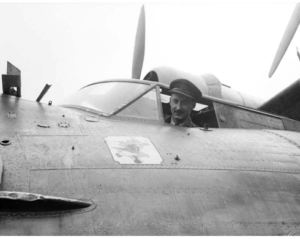
Royal Canadian Air Force Squadron Leader Leonard Joseph Birchall, the “Saviour of Ceylon”
Among RCAF squadrons flying Canso A aircraft, No. 162 (BR) Squadron was the most successful anti-submarine squadron during the second world war with five U-boats destroyed, one shared sinking and one U-boat damaged. This was due to the skill and courage of the crews but also to location.
Formed at Yarmouth, Nova Scotia, on 19 May 1942, it was seconded to RAF Coastal Command in January, 1944, and stationed first at RAF Reykjavik, Iceland, relatively close to U-boat routes from Norway into the North Atlantic. In May, 1944,162 was moved to Wick on the northeast coast of Scotland to intercept enemy submarines leaving Norwegian ports just before and then after the Normandy invasion.
The North Sea between Britain and Norway is an even smaller body of water than that east of Iceland and this, along with German urgency to dispatch U-boats to the English Channel following D-Day on 6 June 1944, probably accounted for the frequency at which U-boats were spotted and attacked by 162 Squadron. [14] Flying from Reykjavik:
F/O C.C. Cunningham and crew attacked a U-boat but could only claim it as damaged.
April 17, F/O T.C. Cooke and crew scored the squadron’s first kill when they sank U-342.
Sorties launched from Wick:
June 3, F/L R.E. McBride and crew sank U-447
June 11, F/O L. Sherman and crew sank U-980
June 13, W/C Chapman and crew sank U-715. Also on this day, F/O Sherman sighted and attacked a U-boat but was shot down.
June 24, F/L D.A. Hornell and crew sank U-1225
June 30, F/L McBride attacked U-478 but the depth charges failed to release. An RAF Liberator was called in and sank the sub.
F/L D. A. Hornell’s attack on 24 June 1944, earned him the Victoria Cross, awarded posthumously. On sea patrol in the North Atlantic Hornell’s aircraft was fired on and badly damaged by U-1125. Nevertheless, he and his crew succeeded in sinking the submarine. Hornell then managed to bring his burning aircraft down on the heavy swell. There was only one serviceable dinghy which could not hold all the crew so they took turns in the cold water.By the time the survivors were rescued 21 hours later, Hornell was blinded and weak from exposure and cold. He died shortly after being picked up. Hornell was laid to rest in Lerwick Cemetery, Shetland Islands. [15]
Author’s note:
A writer faces a difficult decision in choosing to feature individual achievements such as those of John Cruickshank, Leonard Birchall and David Hornell. World War II military personnel served their countries well and many, many people were called upon to do extraordinarily courageous things. Deep gratitude is owed to all veterans of that horrific conflict.
John Clement
And finally, the Canso A history you will not find anywhere else. The writer’s father flew Canso’s with the RCAF from Yarmouth, Nova Scotia, and Torbay, Newfoundland.
Initially posted to 160 Squadron as a 2 nd officer/co-pilot, he was selected for training to qualify as a first officer/captain and was posted to # 3 Operational Training Unit, Patricia Bay, where he flew RCAF 11024 now restored to airworthiness by volunteers of The Catalina Preservation Society and renamed “Shady Lady.”
Training included night landings on the water. The only guide was a line of light buoys anchored in the bay with the other end tied to a boat. The boat’s role was to keep the line taut, directed into the wind. At night, the water was black and the shore was black. With no visual reference other than the string of lights, the pilot had to land on instruments, the artificial horizon and the altimeter.
To prevent the pilot being distracted from the instruments by glancing out the window, at a certain point in the approach the pilot’s seat was lowered so he couldn’t see outside. Training completed, he returned to 160 Squadron as a captain.
No. 160 Squadron Canso’s flying over the Atlantic carried homing pigeons . If an aircraft went down without being able to radio its position, the position could be written on a slip of paper which was to be attached to the bird’s leg and the pigeon released to fly back to the airfield. On every flight the pigeon master sent along the designated emergency pigeon plus a pigeon or two in training. The pigeon cadets were to be released when the plane was a certain distance from the airfield. The pigeons, kept in cages on a shelf in the galley, were not to be fed. The crew fed them bits of toast.
A way had to be found to release the pigeons so they wouldn’t be injured or killed by the back draft from the propellers. The solution was to put the bird in a brown paper shopping bag with the top loosely tucked in. The pigeon, in the paper bag, was put out one of the waist gunners’ blister windows and thrown down to keep it away from the plane’s propeller back-wash and the tail structure. The bag tumbled in the wind until it opened and the bird found its way out and began its flight back to the airfield. [16]
PBYs in the United States Navy and the United States Army Air Force
On December 27, 1941, America’s first offensive airstrike of the Pacific War turned out to be a textbook example of how not to use the PBY Catalina in combat. Six PBY’s took off from Ambon Island in the Dutch East Indies to bomb a Japanese base at Jolo in the southwest Philippines. The Catalina’s were the only aircraft with the range to make the 1,600 mile round trip. Four of the six were shot down and in his post-action report one of the surviving pilots wrote,
“It is impossible to outrun fighters with a PBY-4. Under no circumstances should PBY’s be allowed to come in contact with enemy fighters unless protected by fighter convoy.”
An observation from a PBY Pilot
It was no secret that the PBY’s cruise speed was 125 miles per hour. Perhaps the desire to retaliate after Pearl Harbour clouded the judgment of the commanding officer but after that inauspicious start the PBY distinguished itself in the Pacific as it had done in other theaters of war.
During the Guadalcanal Campaign PBY’s painted matte black were so effective in carrying out night bombing, torpedoing and strafing missions that they became a standard part of the US Navy’s battle plan. The fourteen Black Cat squadrons flying slowly at night, dipping to ship mast height, sank or damaged thousands of tons of Japanese shipping as well as bombing and strafing land based Japanese installations.
Particularly in the Pacific, air-sea rescue PBY’s, flown by the United States Army Air Force and nicknamed “Dumbos” from the original Walt Disney movie that was released during the war, retrieved thousands of downed pilots and shipwrecked seamen. The bunks proved especially valuable on search and rescue missions.
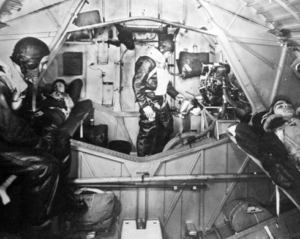
The use of Catalina bunks in a rescue situation.
PBY’s and their crews were very effective in attacking enemy forces directly but their greatest contribution to the war effort was arguably as lookouts.
“…the same phrases reappear in accounts of nearly every WWII naval battle, Atlantic and Pacific: “A PBY spotted the carrier…While Catalina’s shadowed the fleet through the night…As the PBY followed the phosphorescent wakes …When the fog suddenly lifted, the PBY saw the picket destroyers…” [17]
The most significant American PBY discovery of enemy intent: the sighting of the Japanese fleet racing toward Midway.
PBYs in the Royal Australian Air Force
In Australia, “It is often said that the Consolidated PBY Catalina’s were to Australia what the Supermarine Spitfire was to Britain.” [18]
With a Japanese invasion a very real threat early in the war, RAAF Catalina coastal patrols and missions into the Solomon’s were crucial, and when the Allies soon went on the offensive, Aussie Cats ranged as far as the coast of China, mine-laying and night-bombing. It’s said that when the RAAF Catalina crews ran out of bombs, they threw out beer bottles with razor blades inserted in the necks. The bottles whistled as they fell in the dark, which was designed to frighten the Japanese. [19]
From June 1943 to July 1945, Qantas operated flights from Perth to Ceylon, duration up to more than 32 hours, dubbed the “flight of the double sunrise.” These flights carried a maximum of 3 passengers; it was clear that PBY’s were not in a position to be part of the long distance passenger flights that developed in post-war years.
PBYs in the Royal New Zealand Air Force
Fifty-six Catalina’s were operated by the Royal New Zealand Air Force between 1943 and 1953 at an Operational Training Unit in New Zealand and with operational squadrons at various points throughout the Pacific in anti-submarine warfare, shipping escort, air-sea rescue and transport roles. They continued to be operated after World War II because they filled a vital role in South Pacific communications. [20]
Like New Zealand, many countries continued to use PBY’s in their Air Forces for non-combat roles such as air/sea rescue and transportation. The last Catalina in U.S. service was a PBY-6A retired from use on 3 January 1957. [21]
The last Canso in the RCAF, 11089, was retired from service at Downsview on 08 April 1962 and went into civilian service as CF-PQO after being struck off charge on 29 November 1962 [22]
PBYs in Soviet Union Forces
“The Catalina in the Soviet Union was used to carry out a wide range of tasks, from search and rescue operations to anti-submarine missions and everything in between.” [23]
PBYs in the Brazilian Air Force
The Brazilian Air Force flew Catalina’s in naval air patrol missions against German submarines starting in 1943 and also air mail deliveries. In 1943, German submarine U-199 was sunk off the Brazilian coast by a coordinated Brazilian and American aircraft attack. The Brazilians continued to operate military Catalina’s on humanitarian supply flights to outlying settlements in the Amazon area until 1982.
Civilian Roles
Very few PBY-5 flying boats outlasted the war but amphibious PBY-5A models have flown to the present day. In civil aviation the crew dropped to two with the relocation of the engineers engine control panel from the pylon to the cockpit.
Many PBY’s that survived to post war went on to serve on African Safari’s and Canadian fishing charters.
Some surplus PBY’s were converted to flying yachts for the wealthy. Jacques-Yves Cousteau used a PBY-6A to support his diving expeditions.
The Catalina Preservation Society monitors PBY restoration projects around the world. Out of a total production of about 3,305 there are about fifteen airworthy PBY-5A in the world today (2021).
Now that may not seem like a lot until one considers that of the more than 18,000 World War II B-24 Liberator bombers produced by Consolidated and its licensees, only 3 are airworthy today.
PBY’s are still flying because they have not outlived their usefulness, particularly as water bombers. The Catalina Preservation Society “Shady Lady” being a case in point.
Not bad for an airplane deemed obsolete in 1939
Post Script:
The photo below is of the writer’s father, F/L George Clement, and the crew of an RCAF Canso A. F/L Clement is at the far left of the back row. The pigeons were confined to their coop when the photo was taken.
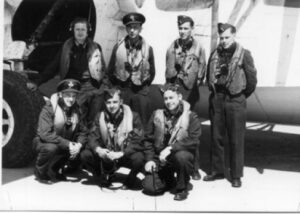
Acknowledgements
Sue McTaggart’s proofreading and editing of an early draft improved my writing. Bob Dyck corrected a comment on Canso handling characteristics that I’d taken from an online site thus preventing me from exposing my absolute ignorance of what it’s like to fly the aircraft. David Legg’s comments proved invaluable in correcting errors in online sources that I’d consulted and adding information that I’d missed, especially the distinction between Canso and Canso A aircraft in the RCAF. The warm receptions of snippets of my father’s story by Sue McTaggart, Derwyn Ross and Ian Scanlon were reassuring. Derwyn initiated the whole process when he asked for a volunteer to take on the task of rewriting the History section of The Catalina Preservation Society’s web site. His comments on the first draft helped me to clarify themes and emphasis that guided me to focus on the story of the aircraft brought to life by the crews who flew her. My heartfelt thanks to you all.
John Clement, December, 2021.
[1] Creed, Roscoe, PBY -The Catalina Flying Boat, Naval Institute Press, 1985.
[2] https://commons.wikimedia.org/wiki/File:Consolidated_XPBY-5A_BuNo_1245_Dec_1939.jpg Click on “File.” “Navy’s new ‘mystery’ plane…”
[3] For a video tour of a PBY-6A, go to https://www.youtube.com/watch?v=GOjE-_cI-K8&t=1091s
[4] The wing was the first “wet” wing on a production airplane, containing the fuel without bladders thus reducing weight by half a pound per gallon of fuel.
[5] As years go by, many Canso pilots report degenerative hearing loss with captains affected in their left ears and first officers in their right.
[6] Calculated by David Legg of The Catalina Society of the United Kingdom. [7] Derwyn Ross, The Catalina Preservation Society.
[8] For a complete account of The Bismarck, go to https://en.wikipedia.org/wiki/German_battleship_Bismarck
[9] Smith was one of nine American officers assigned to the RAF as special observers. Smith was the first American to participate in a World War II naval victory [2] and is sometimes considered the first American to be directly involved in World War II for his actions.
[10] A. E. Godfrey was a remarkable Royal Canadian Air Force officer. On Sept. 22,1943, then Air Vice Marshall Godfrey became the most senior Canadian officer to fire directly on the enemy during World War II. For the full story go to https://legionmagazine.com/en/2005/05/godfrey-of-the-rcaf/
[11] RCAF document dated December 22, 1941 generously shared by David Legg, Editor: The Catalina News, The Catalina Society. https://www.catalina.org.uk
[12] David Legg, The Catalina Society, https://www.catalina.org.uk.
[13] RAF pilot Flight Lieutenant Graham, sent to followup on Birchall’s sighting, also found the fleet. His plane, Catalina Z2144, was shot down. No survivors.
[14] Finding a U-boat was not a totally random process. Once every 24 hours, each U-boat had to extend its radio antenna above water to signal its position to Admiral Karl Dönitz, the commander of the U-boat fleet. Using shore-based receivers and triangulation the allies could track the U-boat radio signals as they left their Norwegian ports.
[15] For more, go to https://en.wikipedia.org/wiki/David_Ernest_Hornell
[16] For a list of all RCAF Canso and Catalina squadrons during World War II, go to https://www.cansofunds.com/the-canso-and-the-catalina-in-the-r-c-a-f/
[17] https://www.navytimes.com/news/your-navy/2019/08/31/cat-tales-the-story-of-world-war-iis-pby-flying-boat/
[18] https://www.awm.gov.au/articles/blog/catalinas-in-the-pacific
[19] https://www.navytimes.com/news/your-navy/2019/08/31/cat-tales-the-story-of-world-war-iis-pby-flying-boat/
[20] https://www.nzcatalina.org/history
[21] https://en.wikipedia.org/wiki/Consolidated_PBY_Catalina
[22] David Legg, The Catalina Society, https://www.catalina.org.uk
[23] https://vvsairwar.com/2017/03/07/the-soviet-pby-catalinas-of-wwii/
Photograph Credits
A – RCAF 11024 A deep gratitude to Professional Aviation Photographer Heath Moffatt for allowing TCPS use of this image
B – xp3y-1 http://www.shu-aero.com/AeroPhotos_Shu_Aero/Aircraft_C/Consolidated/XPY_1_01.html
PBY Variants:
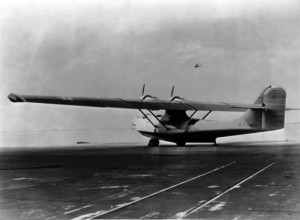
XPY-1 Admiral The Consolidated XPY-1 Admiral, was a modern design for the day, and, the beginning of flying Boat designs that would eventually lead to the PBY, arguably the most successful fly boat ever built.
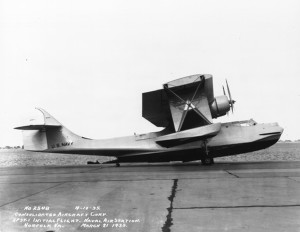
Mk I – RAF Coastal Command Designation of the PBY-5 model series.
PBY-5 – PBY-5A Canso – Canadian designation from December 1941 of the PBY model series as produced by Canadian Vickers in Cartierville Quebec and Boeing of Canada in Vancouver BC.
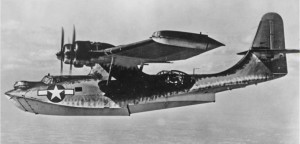
- BOAT OF THE YEAR
- Newsletters
- Sailboat Reviews
- Boating Safety
- Sailing Totem
- Charter Resources
- Destinations
- Galley Recipes
- Living Aboard
- Sails and Rigging
- Maintenance
- Best Marine Electronics & Technology

End of an Era at Catalina Yachts
- By Cruising World Editors
- Updated: December 22, 2020
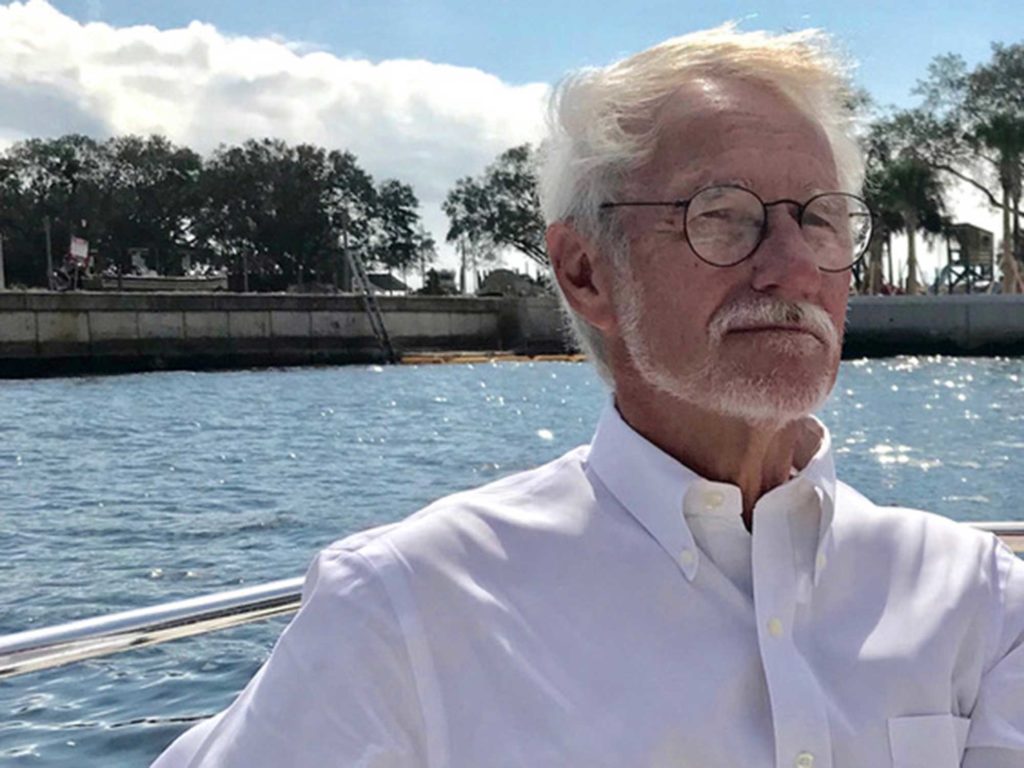
Changes are afoot at Catalina Yachts, America’s largest sailboat builder. Longtime designer and company executive Gerry Douglas has announced that after 45 years with the company, he plans to retire in 2021.
Douglas’ work over the years includes more than 40 designs and the construction of some 60,000 boats built by Catalina in both the California and Florida manufacturing facilities.
Douglas said he will be on hand to finish several ongoing projects, and that a future management team is being assembled. Company founder and owner, Frank Butler, passed away in November.
“I’m grateful to have had the opportunity to do what I love every working day of my life,” said Douglas in a release issued by Catalina this week. “But what is most important to me are the relationships I’ve enjoyed with marine industry colleagues, as well as passionate Catalina owners throughout the world.”
The Catalina announcement continues:
“Douglas says a few of the high points of his career include his first boat designed in 1982, the Catalina 36, of which 2,305 were built.
“Most recently, the Catalina 545, now the flagship of the Catalina fleet, was the overall winner of the 2020 Industry Boat of the Year Award for Cruising World magazine.
“Bookended by those two designs, Douglas delivered the 445 and the 425. Over the course of his long career, his designs won more than 13 Boat of the Year awards, and multiple Best Boat awards from Sail Magazine.
“Gerry Douglas will always be appreciative to the late Frank Butler, founder of Catalina Yachts, for giving him the chance to pursue a long and fulfilling career in yacht design and manufacturing.
“His retirement plans include continuing his work on the Public Arts Commission, yacht club committees, cycling, sailing, racing, cruising and spending time in Florida and at his cottage on the coast of Maine.”
- More: catalina yachts , people
- More People
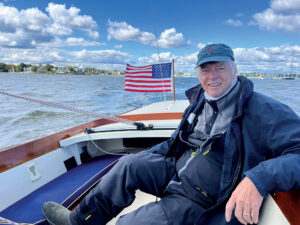
A Legendary Sail
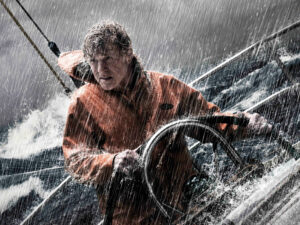
10 Best Sailing Movies of All Time
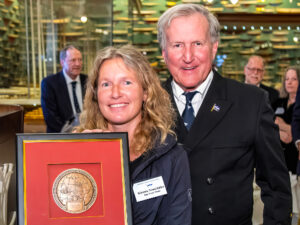
Kirsten Neuschäfer Receives CCA Blue Water Medal
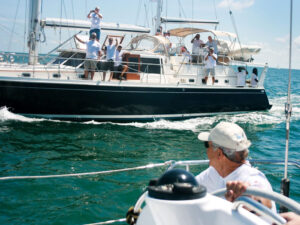
2024 Regata del Sol al Sol Registration Closing Soon

US Sailing Honors Bob Johnstone

Bitter End Expands Watersports Program
- Digital Edition
- Customer Service
- Privacy Policy
- Email Newsletters
- Cruising World
- Sailing World
- Salt Water Sportsman
- Sport Fishing
- Wakeboarding

Catalina 36/375 International Association
You are here, about the catalina 36/375 international association.
The Catalina 36/375 Association is a group of owners and enthusiasts of Catalina 36 and Catalina 375 sailboats manufactured by Catalina Yachts . The first Catalina 36 model was built in 1982. There are two "makes" of the Catalina 36, which continued in production through 1997. The Catalina 375 was manufactured from 2009 through about 2012. You can read all about the history of Catalina 36's and the Association on the History page. The Association has a commodore and a group of Officers , all of whom are volunteers, who run the organization.
This website serves as a landing place for all kinds of information related to Catalina 36 and 375 sailboats. Without becoming a member of the Association, we offer several interesting things within our Community pages including a photo gallery, classified ads, stories of cruises from members, the original model brochures, and a fleet directory.
In addition to the community pages, members have access to a wealth of technical information about the C36 and C375 sailboats. This includes the original manuals, member-contributed "how to" articles, important announcements from Catalina Yachts, boat encyclopedias, the Catalina Yachts monthly Mainsheet magazine, and much more. In addition, we have a very active Forum where members discuss technical and non-technical problems, and exchange information of all kinds. You can read more about member benefits here .
If you own a C36 or C375, or just enjoy learning about them, please consider joining the association . We think you'll find that it's money well spent!
Copyright © 2024, Catalina 36/375 International Association
Theme by Zymphonies

- 360° tours
- services all services brokerage winter storage moorings order work
View Catalina Models

Follow us: | Facebook | Instagram | YouTube | |
New Boat Models:
Catalina and Jeanneau Yachts Open Tuesday - Saturday 8am - 5pm Closed Sunday and Monday
Facebook | Instagram | YouTube |
International Catalina 30/309 Association
Home of the Catalina 30 and 309 Community
Catalina 30/309
Designed around 1974, the traditionally styled Catalina 30 remains extremely popular with cruisers, due to its wide and deep hull creating exceptional volume above and below decks and for its stability under sail. It was offered in standard and tall rig configurations, each with a bowsprit option. Shoal, wing and deep fin keels were offered for varying performance. It offers more space than a typical 34′ boat. There are seven full adult berths, 6′ 4″ headroom and large storage areas under the settees, v-berth, q-berth and in the three cockpit lockers.
There is a large anchor locker in the forepeak. With a huge companionway hatch and large forward hatch, the boat is well ventilated and bright inside. Over the years, many changes were made to fabrics, decorative materials, trim, colors and fashion, and the boat has remained remarkably appealing. The hull Catalina 30 deckhouse, windows and sheer line still define the entire Catalina family of boats.

The original or Mark I model was built from 1975 to 1986 and features the straight cockpit designed for tiller steering and end-boom main sheeting. This model has been widely modified and updated by the owners and improved by the factory with a skeg, a balanced rudder, mid-boom (cabin-top) main sheeting. and pedestal/ wheel steering. It typically had wire-rope external halyards lead to mast winches. The early Yanmar, Universal 5411 and Atomic-4 engines were phased out in favor of the 3-cylinder Universal M-25 diesels during the middle 80s. Design deficiencies with the chain plates (bulkheads) and rudder were eliminated in the late 1970’s production models. Upgrade kits for most of these changes are available from the factory.
The updated Mark II was built from Sept 1986 until 1993 and featured a T-shaped cockpit mold with wide flat coamings and oriented totally to pedestal steering. Halyards were moved inside the mast and lead back to the cockpit. The M-25 became the only engine option in Oct 1988. During this production period, the original SeaWard blocks and Nicro mainsheet gear were replaced by Garhauer equipment. The curved traveler was flattened using more Garhauer equipment. More optional equipment became standard and more opening ports were added, included in the midship hull. The new wing keel option was introduced in Nov 1986. It became standard on the newer Mark III.

The Mark III was introduced in 1994. The broader Mark III stern has a walk-thru transom with boarding/swim platform which takes advantage of the original split backstay. The cockpit is now even more comfortable than ever with wider coamings for outboard seating and new observation seats built into the stern rail. Low maintenance materials have been used extensively to give you more time to enjoy your C-30. New stainless steel traveler supports improve visibility and reduce friction on halyards. The galley has been made even larger with new custom countertop surfaces, more cupboards and drawers, and a dish and cup storage rack. The varnished interior teak cabin surfaces are accented by polished brass light fixtures. Natural light has been increased through the addition of 3 fixed ports in the hull.
Catalina MARK III shares the under body and rig of earlier Catalina 30’s and is eligible to participate in Catalina 30 One Design events and Class Association activities. Mechanical and electrical components remain essentially the same throughout the entire production run. An electrical cable upgrade (cockpit to engine) eliminates some low voltage and charging problems in all three models. Universal, PAR, Seaward (Hillerange), EDSON, and LEWMAR brands are used almost exclusively. Hood and Scheafer furling gear has been standard. Since 1990, Garhauer Marine, has supplied all of the topside rigging and running gear.
Now out of production, last produced at about a dozen per year, the venerable C30 is now the oldest model in the Catalina Yachts family, having the longest production life of over 25 years and nearly 6500 hulls. (A redesigned C22 has been produced since 1995). A MARK IV change was planned in 1997, but was developed as an entirely new boat, the C310 which appeared at the Atlantic City Sail Expo in Feb 1999. The Catalina 30 was inducted into the Sail America Hall of Fame in 2001.
The last Catalina 30 was #6454 5/15/08 – Sold to Catalina Yacht Anchorage out of Channel Islands. Catalina introduced the C309 as the follow-on design for the C30 marketing concept.
During its long production run, the C30 was built in four rigging configurations and three major models or styles. There are three types of keels; the original 5′ 3″ deep keel is still preferred for all-around performance where water depth is no problem. The early 4′ 5″ shoal keel has been replaced by the modern 3′ 10″ deep wing keel. According to the factory, all hulls share the same dimensions and overall weight.
The rigging configurations are the original standard rig (STD), the standard with a bowsprit, a tall rig and the tall mast rig with a bowsprit (TRBS). The bowsprits add about 32 inches to the “J” measurement of the sail plan and the tall mast adds 24 inches to the “I” of the sail plan. The tall mast also has a boom or “E” measurement that is 6 inches longer. The standard boat without the bowsprit is popular along the Pacific coast while the predominant tall rig with bowsprit is the choice in every other sailing area.
The Catalina 30 is widely raced in several large west coast one-design fleets. Otherwise it is a favorite club racer/cruiser in PHRF fleets across the country. The C30 one-design class rules closely follow the PHRF guidelines to lower the costs of competition.

The PHRF ratings split between the standard (STD) and tall rig (TRBS) is usually 18-24 seconds per mile. This wide difference is not supported by most C30 sailors (who know better) and the national one-design rules keep them in separate racing classes. The boat is an excellent performer in flatter water and ocean swells. The sail plan is powerful but the broad hull entry doesn’t slice through choppy or tossed seas as well as some of its contemporaries. The masthead genoas are large, and the main has a moderately tall aspect. That popular 1970’s design theme calls for a spinnaker for off-wind sailing.
A brief type history by David Legg
The PBY Catalina series of flying boats was originally conceived to meet a military requirement and its development built on Consolidated’s experience with earlier flying boat designs. These earlier types had included the commercial Model 16 Commodore and the military Model 22 Ranger/P2Y series.
The Commodore was itself a development of the Model 9 Admiral, or XPY-1 to give it its US Navy designation. The XPY-1 was designed as a US Navy flying boat with the capability of linking the United States West Coast with Hawaii. It was a metal twin-engined monoplane – the first US Navy monoplane seaplane – with a crew of five, the two pilots being in an exposed cockpit, the navigator in the bow, the radio operator in the centre section and the engineer aft. Armament consisted of one 0.30 in machine gun forward of the cockpit and two further 0.30 in guns in an open area further back along the upper hull. Power came from two 450 hp Pratt & Whitney R-1340-38 Wasp engines, although, later, a third engine was installed above the wing. The XPY-1 first flew on 10th January 1929, from Anacostia in Maryland, but it was destined to be a limited edition of one, the Navy ordering the cheaper Martin XP2M and P3M flying boat instead. The solitary Admiral was given the military serial A-8011.
The start of the line – the Model 9 Admiral or XPY-1 Photo: David Legg Collection
Although the Admiral was not a success in terms of military orders, it did give rise to interest from the commercial sector, and this led to the Consolidated Model 16, or Commodore. Design changes included more powerful engines in the shape of two Pratt & Whitney R-1860 Hornets Bs of 575 hp each and a hull that could accommodate up to 32 passengers in some luxury. Initially, it had been hoped that the new type would be sold to the Detroit and Cleveland Navigation Company, which had plans to use the Commodore between destinations around Lake Erie, and to Pan American Airways, but in the event no orders materialised. However, orders did come from Tri-Motor Safety Airways, which wanted to use the type to link North and South America. The prototype first flew on 28th September 1929, and in due course fourteen were built at the Consolidated factory at Buffalo, New York. All those built operated with the launch customer, which, by the time of the first delivery, had been renamed New York, Rio & Buenos Aires Line, or NYRBA, only to be merged with Pan American in September 1930. Production of the Commodore ceased in the following November.
Although the fact that Consolidated’s founder Reuben Fleet was directly involved in the management of NYRBA clearly enabled his company to produce and sell his own design, the Commodore none-the-less indicated that Consolidated was able to build a successful flying boat for commercial use. The next flying boat to be built by the company, however, was another design for the military.
Again based on the earlier, unsuccessful Model 9 Admiral monoplane flying boat, the Model 22 Ranger shared the same upper wing but also incorporated a lower, shorter-span wing supporting the two floats. It too had a covered cockpit for the flight crew as on the Commodore, and it was at first powered by three Wright R-1820E Cyclones of 575 hp, later reduced to two. Given the US Navy designation XP2Y-1 and serial Bu8939, the initial example took to the air for the first time on 26th March 1932.
Consolidated went on to produce another 23 twin-engined P2Y-1s for the US Navy, and these were allocated serials Bu8986 to 9008. The final aircraft was completed in June 1933, and was modified a few months later to become the first PY2-2 powered by two 750 hp R-1820-88s. These engines were mounted upon the wing leading edge rather than between the hull and the upper wing as on the P2Y-1. Nearly all of the latter were subsequently upgraded to P2Y-2 standard. The two unconverted aircraft were exported, one to Colombia for air force use and the other to Japan. Incredibly, the South American aircraft remained in service until as late as 1948, by which time it had been supplemented by a number of Catalinas. The Japanese example was used commercially during World War Two.
There followed a further 23 P2Y-3s (Bu9551 to 9571 and 9618 to 9619) of similar configuration to the P2Y-2 but with uprated R-1820-90 engines and greater fuel capacity. A further six were produced to meet an Argentine Navy order in mid-1936, and these flew on until 1947 when, like the Colombian P2Y-1, they were replaced by Catalinas. The US Navy aircraft were used by various patrol squadrons, and many ended up at NAS Pensacola in Florida, where they were used to train flying boat crews, including many who were later to become RAF Catalina personnel.
A twin-engined P2Y-3 at San Diego showing the high strut-mounted wing and much shorter shoulder-mounted lower wing with floats attached Photo: David Legg Collection
The Commodore and Ranger designs only bore a passing resemblance to the PBY inasmuch as the side profile of the lower hull and step were similar. Both types showed evidence of reliability and the capability of long distance flight for both military and commercial users, and it was whilst the early examples of the P2Y series were being produced that the Consolidated designer, Isaac Laddon, began design work on what was to eventually become the Consolidated Model 28/PBY Catalina series.
This design was known initially by its military designation XP3Y-1, and was prompted by a 1933 United States Navy contest inviting manufacturing companies to submit entries to meet the requirements for a military patrol flying boat with an operational range of 3,000 miles and a cruise of 100 mph. Consolidated submitted its design and the US Navy liked what it saw. Reuben Fleet’s company was rewarded with a contract to build one aircraft at the end of October 1933. Rival firm Douglas had previously been given a similar contract to develop its own submission – the XP3D-1; indeed, the Douglas aircraft was the first to fly, beating the Consolidated aircraft off the water by more than a month.
Isaac Laddon incorporated a number novel features into his XP3Y-1 layout, in particular the pylon-mounted parasol wing and the retractable floats that changed the flying boat’s wingspan in flight. The competing Douglas, on the other hand, was rather more conventional, slightly smaller overall, with the wing mounted shoulder-like high up the hull sides and with engines raised above the wing surface on pylons. The powerplant chosen for both the designs was the 825 hp Pratt & Whitney R-1830-58 Twin Wasp, a good choice that in uprated versions was to see the PBY series through to the end of production in 1945. Performance for both the XP3Y-1 and XP3D-1 was broadly similar, although the Consolidated design had the edge. What really clinched the Consolidated aircraft for the Navy, however, was the unit price – the Douglas design at $110,000 was as much as $20,000 dearer than the XP3Y-1. It will never be known whether the Douglas aircraft would have gone on to be such a famous and durable design as the Catalina had it won through and been accepted by the US Navy.
The sole XP3Y-1 was built at Buffalo in New York, construction starting toward the end of 1933. Its first flight was undertaken from the Naval Air Station at Norfolk in Virginia, this decision being taken because of the possibility of icing on Buffalo’s Niagara River. The almost complete airframe was taken by rail to Norfolk NAS, where final assembly took place and the maiden flight was successfully achieved on 21st March 1935. Further test flights were conducted from Norfolk and Anacostia. The flying boat was given the US Navy serial Bu9459.
The US Navy made a few recommendations for modifications, which included a rear hull extension, the installation of a gun position in the lower hull aft of the keel and a revised profile to the bow turret. Generally, though, the clean lines of the hull and wings were to remain virtually unaltered through all the subsequent versions of the PBY. The only major change to the design came during the Second World War, when the Naval Aircraft Factory came up with the rather more aggressive-looking PBN-1 Nomad. However, one particular problem dogged the design from beginning to end – directional stability. The XP3Y-1 alone underwent three changes of rudder profile, and even after these were introduced, problems persisted. In fact, rudder re-design was to be a feature of the subsequent Consolidated Model 28/PBY series throughout its design life and even on into the post-war period! In all other respects, however, Laddon had got it right. The prototype received uprated engines in the shape of the Pratt & Whitney R-1830-64 of 850 hp and it became the XPBY-1 prototype.
Prior to being re-engined, Bu9459 proved its ability to make long-distance flights by completing the journey between Norfolk, Virginia and Coco Solo, Panama Canal Zone, then flying on to San Francisco, California. This occurred in October 1935, and the latter leg created a record for the longest distance flown by a seaplane up to that time.
Satisfied with its choice, the US Navy placed its first order with Consolidated at the end of June 1935, this being for a total of 60 aircraft to be known as the PBY-1, and the company began to plan production at its new facility at Lindbergh Field, San Diego, California. Incidentally, the PBY designation recognised the type’s ability to operate not only in the originally intended patrol role but also as a bomber – P=Patrol, B=Bomber, Y=Consolidated. Service deliveries began in September of the following year, with the first examples going to VP-6 and VP-11, both based at the Navy’s North Island facility across San Diego Bay from the Consolidated factory. The former squadron soon relocated to Pearl Harbor, Hawaii, and flew its twelve aircraft in a non-stop formation delivery flight, a feat to be copied by various other squadrons as they took on aircraft and left the USA to establish their new overseas bases. Other squadrons to take delivery of PBY-1s included VP-12 at Sands Point, Washington, and VP-3 at the Panama Canal Base of Coco Solo.
The sixty PBY-1s gave good patrol squadron service during the pre-war period, and a number were still based in Hawaii at the time of the Japanese attack on Pearl Harbor in December 1941 though all had been relegated to second-line service by then. None were to remain in use in post-war peacetime. This first US Navy batch of PBYs was serialled consecutively in the sequence Bu0102 to Bu0161.
Even before the first of the 60 PBY-1s were delivered, the US Navy issued a follow-on order in July 1936 for 50 aircraft to be designated PBY-2 and serialled Bu0454 to Bu0503. The main distinguishing feature between the PBY-1 and PBY-2 was a re-designed horizontal tail and elevator assembly, although some of the PBY-2s also had Curtiss props rather than Hamilton Standards. In addition, the PBY-2 had an increased bomb load capability. Deliveries began in the summer of 1937, and the PBY-2 flew with VP Squadrons 2, 7, 10, 11 and 17 from bases in the USA, Hawaii and the Canal Zone. By mid-1942, the remaining PBY-2s had been relegated to second-line, training and support roles, and like its predecessor, had been withdrawn from use entirely by the war’s end.
A PBY-2 of US Navy patrol squadron VP-11 clearly showing the soon-to-be familiar Catalina lines but with earlier rudder design Photo: David Legg Collection
The next US Navy order was for 66 PBY-3s, placed in November 1936. Again, only detail differences distinguished the new variant. It shared the PBY-2’s tail re-design but was powered by the more powerful P&W R-1830-66 of 900 hp rather than the earlier –64, and this change necessitated a relocation of the carburettor air intake from underneath the lower cowling to above the top cowling close to the exhaust outlet. Prior to the outbreak of hostilities with Japan, the US Navy flew PBY-3s within VP Squadrons 7 and 9 at San Diego; 4, 18, 21 and 22 at Pearl Harbor and VP-5 at Coco Solo. The type also equipped Seattle-based VP-16 and VP-32. A number of PBY-3s were lost in the attack on Pearl Harbor, and subsequently this variant followed the lead of its two earlier versions and was relegated to second-line tasks, with some examples still being on US Navy charge as late as May 1945. The 66 PBY-3s carried the Bu numbers 0842 to 0907.
A further change of powerplant to the 1050 hp R-1830-72 and the addition of prop-spinners distinguished the PBY-4 from the PBY-3. However, the PBY-4 was to be produced in smaller numbers, only 33 being ordered, with serials Bu1213 to 1245, of which 32 were actually built as PBY-4s. They served with VP-1 (later VP-21 for a while) at Pearl Harbor and in the Philippines, where the Squadron was designated VP-101. It also equipped VP-18 at Pearl Harbor. The latter squadron was renumbered VP-26 in July 1939, and went out to the Philippines to become VP-102. It was around this time that the US Navy PBYs began to lose their colourful pre-war liveries and started to adopt a more sober blue-grey. Although the type continued in use after the outbreak of hostilities, it was declared obsolete by the war’s end. Like the PBY-1, -2 and -3 before it, none served as either military or commercial aircraft beyond 1945.
Consolidated continued to look at the PBY design and make modifications to it. Three of the last PBY-4s (serials Bu1241, 1242 and 1243) were used as pattern aircraft for rear hull blister gun emplacements installed in place of the sliding hatches that had been employed up to that point. They also had minor modifications to the rudder trailing edge. Bu1241/13-P-12 of VP-13 was also used for trials of yet another vertical tail/rudder design, and both the blisters and the new rudder were to become standard for the PBY-5 variant to follow.
With all PBYs delivered and no further orders from the US military forthcoming, future prospects for the type were not looking so rosy by the summer of 1939. However, events in Europe were to change all that and lead to production levels that could never have been envisaged when the XP3Y-1 was first on the drawing board! The British ordered Model 28-5s/PBY-5s in some number, and this revitalised production. The US Navy also ordered 200 PBY-5s with 1,050 hp Pratt & Whitney R-1830-72 engines at the end of December 1939, with deliveries beginning in the following September although the final 33 aircraft were built as PBY-5As. Follow-on orders continued as the war progressed and the USA’s involvement in it expanded. The British-inspired name Catalina was bestowed on the type, the USA also adopting this sobriquet, and thereafter it became the type’s official name, although, it continued to be called the PBY by many US servicemen, along with other less polite nicknames!
A fine air-to-air of VP-44’s aircraft ‘2’ Photo: via Barry Dowsett
As mentioned above, the final PBY-4 was not initially delivered to the US Navy for squadron use but was retained by the manufacturers for further design work. In fact, it was used for trials of the amphibious undercarriage system that was to provide future Catalinas with so much flexibility and that was ultimately to ensure the type’s longevity. Bu1245 had its weight increased by 2,300 lbs through the addition of two main wheel units, a nose wheel assembly and associated wheel well bays and doors. Although at first it was not fitted with blisters and it retained the original shape PBY-4 rudder, it became the prototype PBY-5A (XPBY-5A), first flying as such on 2nd November 1939. The US Navy, realising the type’s potential, decided that its then current order for PBY-5s should be amended to PBY-5As, and thereafter ordered many more. The British remained distinctly cool about the added wheels, however, and stuck to the pure flying boat variant, although one small order for twelve amphibious Catalina IIIs was placed.
As an interesting aside, Bu1245 was later delivered to the US Navy and used as a staff transport in both the Atlantic and Canal Zones. Starting in March 1943, it underwent modifications that saw it lose its amphibious undercarriage but gain a PBY-5 tail and blisters. More radically, it lost its bow turret in favour of a faired-over ‘clipper’ bow – shades of things to come in the post-war commercial sector – and had an internal fit allowing seating for a number of passengers. In this unarmed guise, it became the PBY-5R Sea Mare.
At the start of hostilities between the USA and Japan in December 1941, the US Navy’s PBY squadrons were based in various locations around the US mainland – Alaska, Washington State, Virginia, California and overseas at locations including Hawaii, Pearl Harbor, the Canal Zone and the Philippines.
Prior to the USA entering the Second World War, the second production PBY-5, Bu2290, was transferred by the US Navy to the US Coast Guard, with which it adopted the serial V189. Initially flown in a high visibility livery of overall aluminium but with yellow-orange upper wing surfaces and red and white vertically striped rudder topped with blue, it later adopted a more sober grey scheme when in wartime use up in Alaska. It remained in service until at least 1943, when it was stationed in the San Francisco area, and it was the predecessor for many more wartime and post-war USCG Catalinas.
As the war progressed, Catalinas of both flying boat and amphibian varieties continued to be produced at the Consolidated factory in San Diego, production later being switched to the plant at New Orleans. Aircraft were supplied not only to the US forces and the Royal Air Force but also to the Royal Australian Air Force, Royal Canadian Air Force, Netherlands Navy and Royal New Zealand Air Force. Additional production was contracted out to Canadian Vickers, initially at St Hubert and later at Cartierville, Quebec, and to Boeing of Canada at Sea Island, Vancouver, BC.
A war weary Catalina IB of the Royal Air Force South East Asia Command. FP229 served with 302 Ferry Training Unit, 270 and 205 Squadrons before being struck off charge in September 1944 Photo: David Legg Collection
In the main, the design of the Catalina remained fairly constant once PBY-5 production commenced, the main modifications being the addition of an amphibious undercarriage to some versions, changes to the bow turret and to the vertical and horizontal tail surfaces. The latter redesign was a feature of the flying boat PB2B-2 and PBY-6A. It also appeared on the somewhat more radical but less successful PBN-1 Nomad developed by the Naval Aircraft Factory in Philadelphia and supplied to both the US Navy and the USSR. In addition to the changed tail, the Nomad also had a revised hull and float shape and a new bow turret.
The PBY-6A, widely used by the US Navy, featured a taller tail/rudder and wider span elevators. This example, BuAer46642, shows the later ‘eye-ball’ bow turret and AN/APS radar housing above the cockpit Photo: David Legg Collection
The Naval Aircraft Factory developed the Catalina into the PBN-1 Nomad but most examples were supplied to the Soviet Union. In addition to the PBY-6A-style tail and rudder, the Nomad had a more streamlined bow, hull and floats but was only built in flying-boat format Photo: David Legg Collection
The Catalina served with distinction throughout the Second World War and was involved in many significant actions including the location of the German battleship Bismark, the sighting of the Japanese invasion force heading for Ceylon and many individual actions against U-boats and submarines. Two Victoria Crosses were awarded to Coastal Command Catalina captains. In the main, the type carried on its role of maritime patrol, characterised by long, monotonous sorties without sighting land or enemy.
With the Second World War over, the various military air arms that were operating the Catalina in all its different marks began a rapid down-sizing of its fleets. Further details are given under the entries for the individual countries involved. In summary, the USA continued to operate amphibious versions with the United States Army Air Force (United States Air Force from September, 1947, onward), the US Navy and the US Coast Guard but none of these were flying pure flying boat PBY-5s or PBN-1 Nomads post-war. Indeed, only one complete US Navy PBY-5 was to survive for posterity, this being Bu08317 which can be found today lovingly restored at the United States Naval Aviation Museum at Pensacola in Florida. Large numbers of Navy, Army and Coast Guard Catalina amphibians were commercialised throughout the late-1940s and the 1950s however.
Of the Commonwealth air forces, the Royal Air Force disposed of its entire fleet with almost indecent haste but the Royal New Zealand Air Force and Royal Australian Air Force continued to use their Catalinas in decreasing numbers for a few more years, small numbers transferring to the commercial sector. The Royal Canadian Air Force did not operate flying boat Cansos post-war although they used a fair number of their amphibious Canso As well into the 1960s. Many of the Canso As were subsequently disposed of to civil operators as they came up for tender although no pure flying boat versions were sold for commercial use.
So, having acquitted itself so well during the ‘war, the Catalina found itself suddenly poised to embark on a new career once it had ended. The irony is that, having been conceived as a flying boat, its saving grace as far as its future longevity was concerned was the fact that it had been developed into an amphibian! The addition of a retractable undercarriage gave the PBY so much more flexibility that many post-war commercial and military operators leapt at the chance of buying up surplus military examples. In fact as time went on, a fair number of the aircraft that continued in use were operated almost entirely from land and rarely if ever ventured onto water! Conversely, the ability to operate from water led to the Catalina flying in commercial roles that were far beyond the original vision of the Consolidated design office! Notwithstanding the above, a small number of pure flying-boat examples did fly commercially although even some of these were originally built as amphibians and had had their undercarriage units removed and the bays plated over.
During its long post-war career as a commercial aircraft, the Catalina was used in a variety of ways. These included the relatively conventional roles of passenger and freight transport, executive aircraft and rich man’s airborne yacht. As time went on, it also carved out a niche for itself in a small number of highly specialised roles. The first – aerial survey – relied on the type’s ability to fly steadily for long periods whilst being equipped with a variety of external equipment hung around its airframe. The other – aerial fire fighting and spraying – was to a great extent based on the Catalina’s water-landing capability although ironically a number of those flown in the USA against forest fires were land-based. It is a fact that these two activities have contributed greatly to the Catalina’s longevity and have been responsible for the continued existence of many of the world’s remaining flying specimen’s. Catalinas have also been involved in air display and film work and in some notable long-distance flights.
It seems that despite the fact that surviving Catalinas had all reached at least their 55th birthday by the end of the second millennium, some of them were still capable of carrying out very long over-water trips without incident, surely a great tribute to the design and the present day owner/operators who have kept them flying.
Copyright © David Legg May 2006, 2011
PBY Catalina Documentary
Be kept up to date on all the latest Catalina goings-on around the World!
Popular Pages
- Memberships & Renewals
- Cat Pack Volunteers
- Survivors List
- Share Ownership
- World Catalina News (WCN)
- Our History
Help Support Us
Duxford base events.
See full event list
No event found
Catalina world events, le temps des hélices 2024.
At LE TEMPS DES HÉLICES 2024
Find out more...
RAF Cosford Air Show 2024
Let your imagination Take Flight at the RAF Cosford Air Show!
Flugplatzkerb Gelnhausen
Recent Articles
Recent comments.
- World Catalina News – November 2023 27th October 2023
- World Catalina News – July 2023 13th July 2023
- World Catalina News – November 2022 30th November 2022
- The Crazy WWII Catalina Flying Camper 29th July 2022
- Special Event for Future Catalina Shareholders 2022 27th June 2022
- PBY-5A ‘Miss Pick Up’ Display at RAF Cosford 2022 in 4K 22nd June 2022
- World Catalina News – June 2022 5th June 2022
© 2024 The Catalina Society. Privacy Policy Site Design & Hosting by Mike Pinder Photo: @vimarethomas
- Join The Catalina Society
- Membership Renewals
- Become A Shareholder
- Join The Cat Pack
- Press & Video
- Live GPS Tracker
- Photo Gallery
- 360 Virtual Tour
- Community Photos
- ‘Cutaway’ Drawing
- Catalina History
- History of 44-33915
- Our Catalina – G-PBYA
- Founding Members
- Related Web Sites
Catalina Newsletter
Latest news.
- World Catalina News – November 2023
- World Catalina News – July 2023
- World Catalina News – November 2022
- The Crazy WWII Catalina Flying Camper
- Special Event for Future Catalina Shareholders 2022
- PBY-5A ‘Miss Pick Up’ Display at RAF Cosford 2022 in 4K
- World Catalina News – June 2022
Catalina Gifts
Privacy overview.

CATALINA YACHTS
Massey yacht sales is your nation leading catalina broker. ask us more today, catalina info.
Established: 1989
- Located: Corporate Headquarters-Woodland Hills, California —Catalina production factory-Largo, Florida
Construction: Fiberglass
Category: Sailboats
- Fun Fact: Catalina Yachts is the largest manufacturer of American owned, American designed and American built sailing yachts.
Catalina builds the largest selection of honest, sturdy boats that hold up to real world conditions, perform well and cost less to maintain. For Catalina owners, this means lots of extra value and enhanced sailing pleasure, with the added bonus of excellent resale value.
Catalina’s broad range of intelligently designed family-oriented sailboats includes the SPORT SERIES, with sprightly 8–27 foot day sailors, the CRUISER SERIES capable, roomy mid-sized yachts from 31–35 feet, and the majestic OCEAN SERIES 38–44 footers for more serious offshore adventures.
No matter what size boat fits your lifestyle, at Catalina it is about creating the best possible ownership experience. So if you’re looking for a long–term relationship with a high–quality American brand, it’s time to take a closer look at Catalina Yachts – standing firmly behind our hand–crafted sailboats for over 40 years.
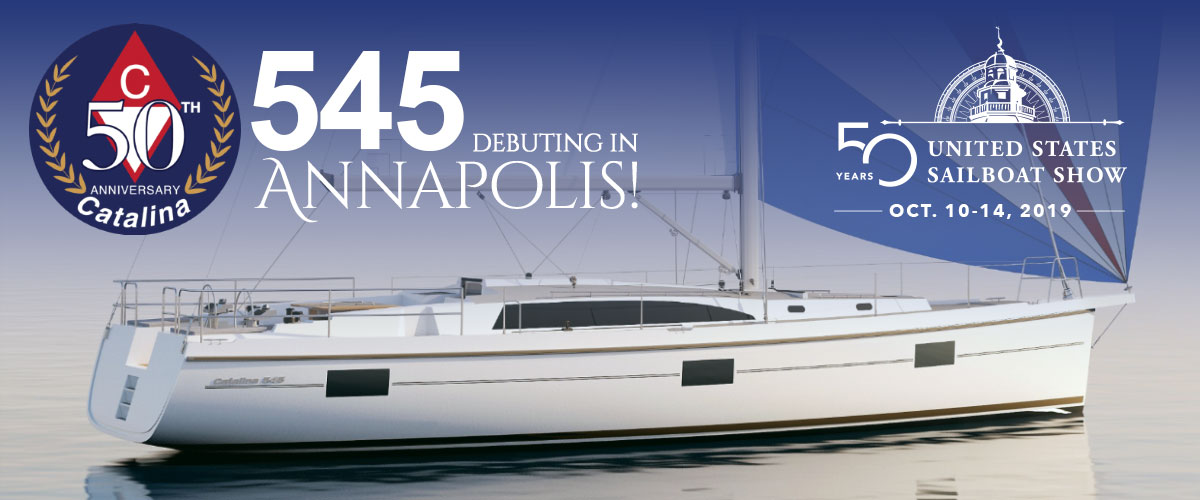
Your Catalina Experts
The Massey yacht sales teams are Catalina experts. We have been selling and outfitting new Catalina’s consistently since 1978. Massey is the closest dealership to the Catalina production plant in Largo, Florida. We visit the factory often and know the specifics regarding the Catalina build, from stem to stern. Sharing that knowledge is part of what we offer to our Catalina purchasers.
Ed Massey personally oversees the make ready for each new Catalina delivered by Massey Yacht Sales. Ed has a well-earned reputation for being extremely thorough in testing all the systems and making sure every detail is checked off prior to delivery.
When it’s time for hand over to the new owner we include an expansive four day orientation by a friendly teaching instructor. When you head out to the open seas you will know your Catalina, her systems and handling characteristics very well indeed.
You can trust the Massey sales team to be your best source of information and expertise when it comes to assisting you in acquiring your new Catalina yacht.
NEW CATALINAS
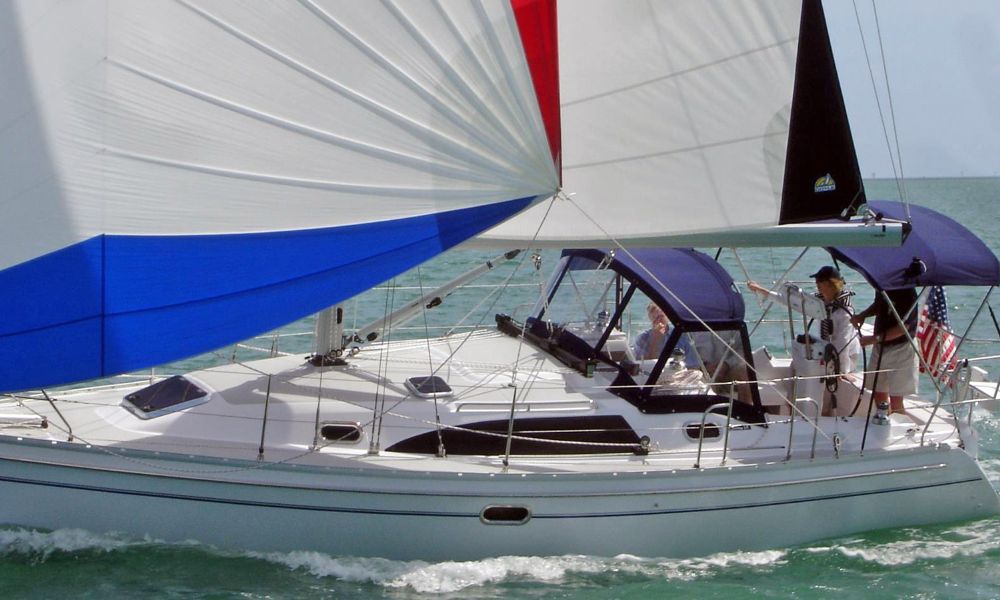
Catalina 315
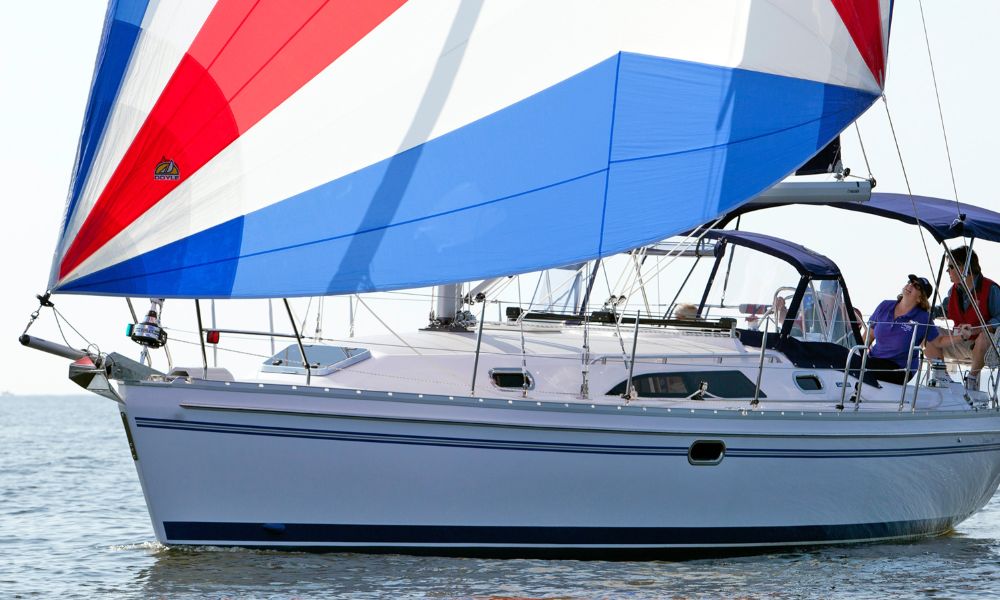
Catalina 355
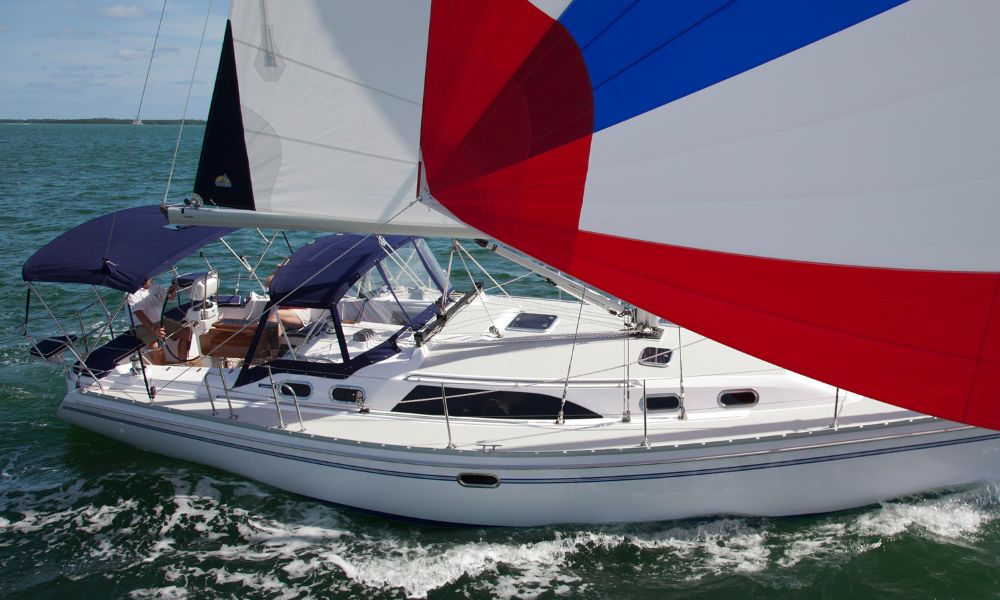
Catalina 385
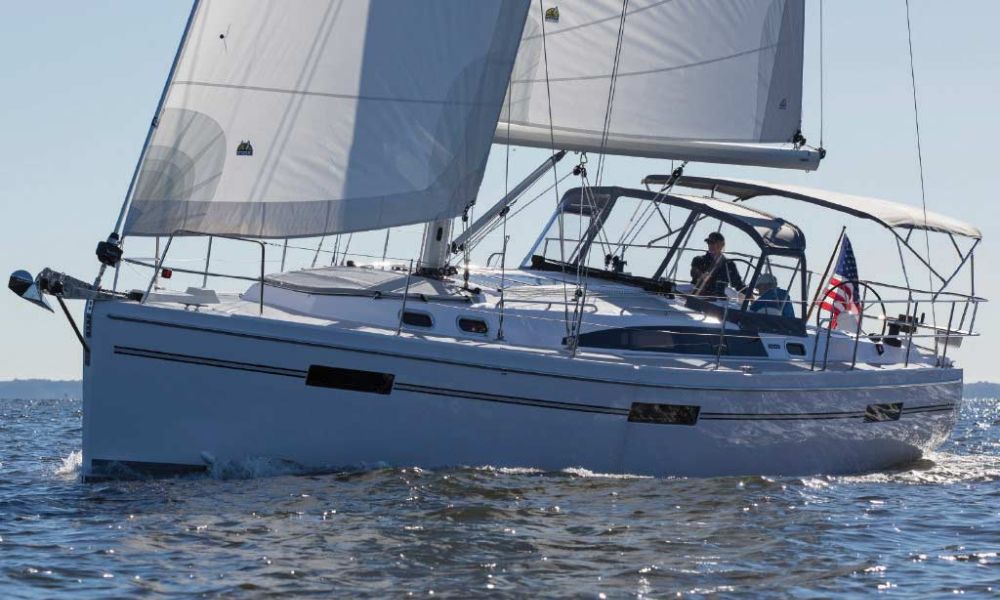
Catalina 425
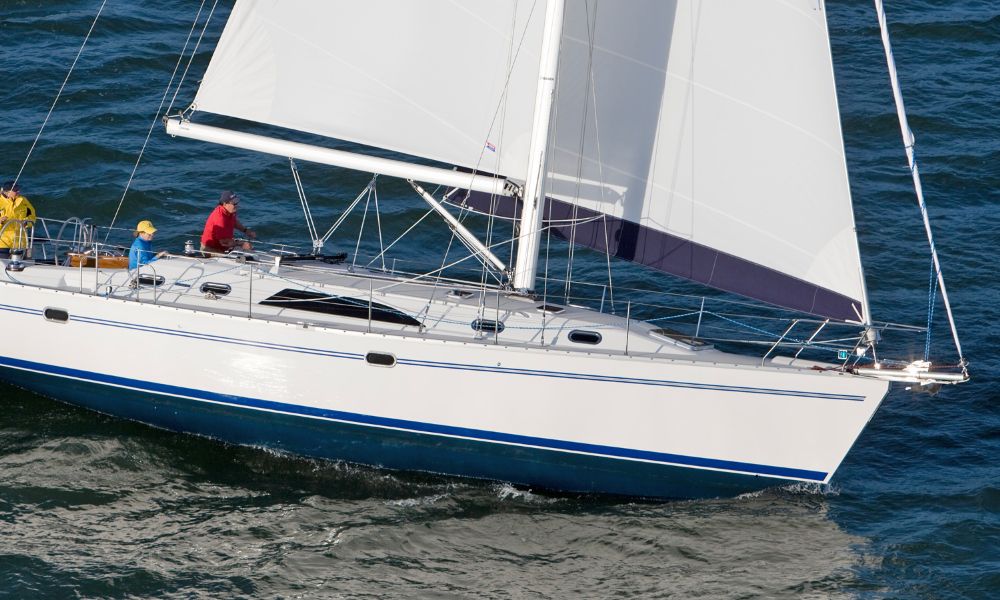
Catalina 445
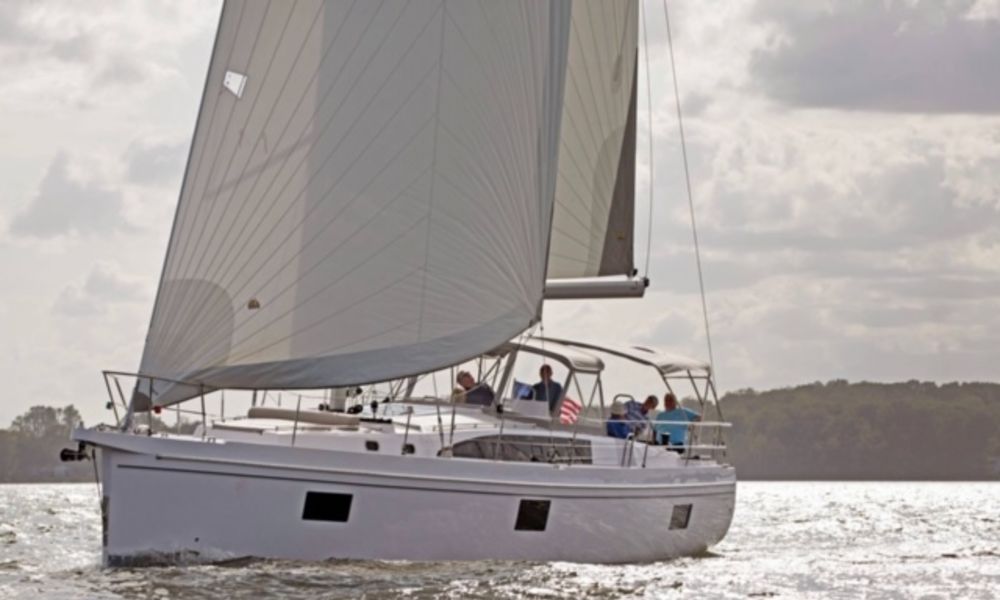
Catalina 545
Catalina yachts by model, catalina yachts by size, catalina yachts by price range, catalina yachts by type.

No risk to you — 100% satisfaction guaranteed! Order Now
Catalina Serial Number Lookup and Hull Identification Number Decoder
Get a free boat vin lookup and decode for catalina..
The first three characters of the Hull Identification Number (boat VIN) affixed to the transom of the boat hull designate the manufacturer of the boat. This is called the Manufacturers Identification Code (MIC) and are assigned by the U.S. Coast Guard. The MIC for Catalina is CTY.
All manufacturers who historically used CTY:
- CATALINA YACHTS
In Business We believe this boat manufacturer is currently in business.
Contact Details for Catalina.
These are just some of the Catalina Hull Id Numbers / Boat VINs we've seen when analyzing accident, registration and coast guard databases to try to determine if there is anything to worry about in the boat's history.
Sample Catalina Hull Identification Numbers (HINs)

IMAGES
VIDEO
COMMENTS
CHRONOLOGICAL HISTORY. July 1969 Catalina´s first model, the Catalina 22, is built in North Hollywood, CA. Company owner Frank Butler hopes to build 100 boats if all goes well. March 1970 Catalina´s second model, the Catalina 27, is introduced following the success of the Catalina 22.
Catalina Yachts is a U.S.-based builder of fiberglass monohull sloop-rigged sailboats ranging in sizes from eight to 54 feet in length. It was founded in 1969 in Hollywood, ... History. In 1961, Catalina Yachts founder Frank Butler (January 17, 1928 - November 15, 2020) ...
Founded by Frank Butler. In sheer numbers sold, Catalina Yachts is certainly the most successful builder of sailboats ever in the US, and possibly the world. Time line extract from the company's website: July 1969-Catalina's first model, the Catalina 22, is built in North Hollywood, CA. Company owner Frank Butler hopes to build 100 boats if all goes well. March 1970-Catalina's second ...
Catalina has been continuously producing yachts for 50 years. Catalina is owned, designed and built in America under the same ownership since day one. Catalina resale values and customer loyalty are among the highest in the industry. Dollar for dollar and feature for feature Catalina is a better, safer sailing yacht.
February 1995-The Catalina 22 is named as one of five charter members to Sailboat Hall of Fame. March 1995-The Catalina 36 mark II wins one of Cruising World Magazine's "Boat of the Year" awards. April 1995-Catalina 250 Hull number 100 is built in Woodland Hills. May 1995-Catalina 42 hull number 500 is built in Woodland Hills.
The sailing community this week lost a giant among the ranks of production boat builders. Frank Willis Butler, president and chief executive officer of Catalina Yachts, passed away November 15, 2020 in Westlake Village, CA, due to unexpected complications from a recent illness. In making the announcement, Catalina said, "We extend our most ...
Catalina introduced a design with new materials and modern open interior. "There's nothing pretentious about the boat, it just works," according to Catalina Yachts' Gerry Douglas. "It could be considered the Model T or Volkswagen Beetle of the sailing world." With a user friendly cockpit, simple but workable
History. The Catalina 27 was conceived in a 1970 design partnership between Robert Finch, and the founder of Catalina Yachts, Frank Butler. Butler built an incredible number of 27s at his boat factory in Southern California using modern boatbuilding processes that are not too different to methods employed today. Initial production started in 1971.
Which brings us to the Catalina 34. Exactly 1,800 Catalina 34s were built between the years 1991-1999, and the boat has gone through several iterations. The hull we focus on here is the relatively narrower one built between 1986 and 1995, generally referred to as the Mark 1, or Mark 1.5. The Catalina 34 sold between 1994 and 2001 (production ...
CONSOLIDATED PBY / Catalina / Canso History. A brief PBY History by: John Clement . Development. The plane that would become the PBY Catalina was designed by Consolidated Aircraft Corporation's lead designer, Isaac Machlin ("Mac") Laddon when, in 1933, the United States Navy, wary of Japan's growing influence in the Pacific Ocean, requested competing prototype designs for a flying boat ...
Advertisement. "Most recently, the Catalina 545, now the flagship of the Catalina fleet, was the overall winner of the 2020 Industry Boat of the Year Award for Cruising World magazine. "Bookended by those two designs, Douglas delivered the 445 and the 425. Over the course of his long career, his designs won more than 13 Boat of the Year ...
The Catalina 36/375 Association is a group of owners and enthusiasts of Catalina 36 and Catalina 375 sailboats manufactured by Catalina Yachts . The first Catalina 36 model was built in 1982. There are two "makes" of the Catalina 36, which continued in production through 1997. The Catalina 375 was manufactured from 2009 through about 2012.
Catalina celebrates 50 Years! A Chronological History 1969 - 2019 When Frank Butler founded Catalina Yachts in 1969, it wasn't his intention to become the largest sailboat builder in the United States. His goal was, and still is, to build good boats that are a good value for Catalina's customers.
The last Catalina 30 was #6454 5/15/08 - Sold to Catalina Yacht Anchorage out of Channel Islands. Catalina introduced the C309 as the follow-on design for the C30 marketing concept. RIGGING. During its long production run, the C30 was built in four rigging configurations and three major models or styles. There are three types of keels; the ...
Interior Finish History. 09/25/13. This article details the history of the interior finishes used by Catalina Yachts over the many years of production. With a history of the products used, one can make an informed decision regarding which product to use to keep the boat looking nice. There are links within this article that will take you ...
A brief type history by David Legg. The PBY Catalina series of flying boats was originally conceived to meet a military requirement and its development built on Consolidated's experience with earlier flying boat designs. These earlier types had included the commercial Model 16 Commodore and the military Model 22 Ranger/P2Y series.
Notes. With more than 6000 sold, the Catalina 30 is one of the most successful production sailing yachts in history. During the long production run of this basic model there were a great number of variations with standard and tall rig configurations, each with a bowsprit option, and also including shoal, wing and deep fin keels.
CATALINA 445. CATALINA 545. CATALINA YACHTS Massey Yacht Sales is your Nation Leading Catalina Broker. Ask us more today! Catalina Info Established: 1989 Located: Corporate Headquarters-Woodland Hills, California ---Catalina production factory-Largo, Florida Construction: Fiberglass Category: Sailboats Fun Fact: Catalina Yachts is the largest ...
Contact Details for Catalina. FAX: (818) 884-3810 CATALINA YACHTS/MORGAN DIVISION 7200 BRYAN DAIRY ROAD LARGO, FL 33777 PH: (727) 544-6681. E-MAIL: [email protected] LAT/LONG: 27.868N 082.739W. MOVED FROM FLORIDA. 940624 ADDED FLORIDA ADDRESS BASED ON LETTER FROM CATALINA RE CASE 940097S.